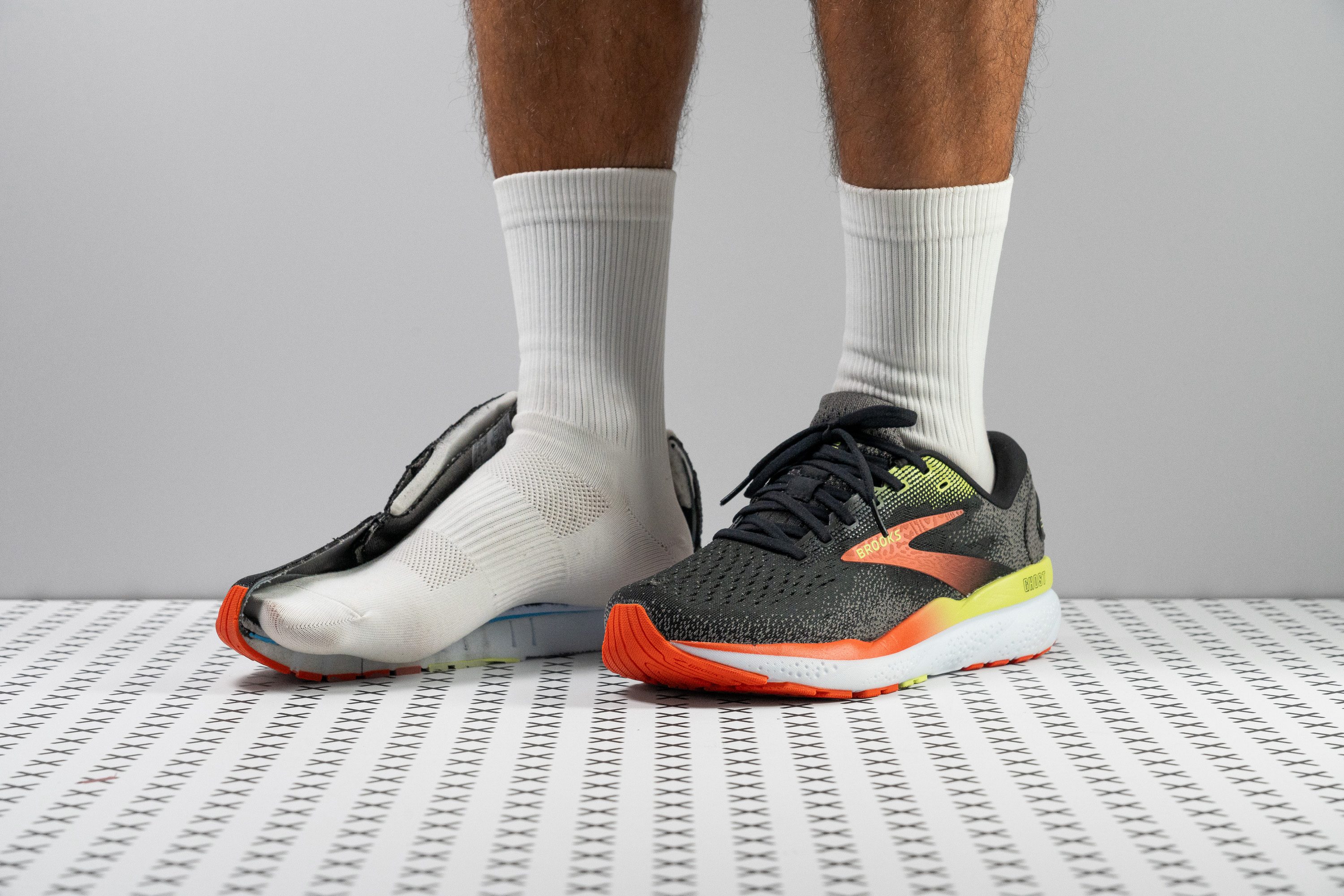Our verdict
- Top pick in best running shoes for beginners
Pros
- Fiables
- Ideales para los talonadores
- Suela exterior hecha para durar
- Muy estables
- Más reactivas
- Versátiles para varias actividades
- Mantienen un precio asequible
- Mantienen un precio asequible
Cons
- Lengüeta sin refuerzo
- Contrafuerte del talón rígido
- Parte delantera con poco volumen vertical
- Siguen necesitando un mejor retorno de energía
Audience verdict
- Top 4% most popular running shoes
Comparison
The most similar running shoes compared
+ + Add a shoe | |||||
|---|---|---|---|---|---|
| Audience score | 81 Good! | 78 Decent! | 84 Good! | 87 Great! | |
| Price | £135 | £140 | £160 | £140 | |
| Pace | Daily running | Daily running | Daily running | Daily running | |
| Shock absorption | High | High | Moderate | High | |
| Energy return | Moderate | Low | Low | High | |
| Traction | High | High | High | High | |
| Arch support | Neutral | Neutral | Neutral | Neutral | |
| Weight lab Weight brand | 9.4 oz / 266g 9.5 oz / 269g | 10.2 oz / 289g 10.1 oz / 286g | 9.1 oz / 257g 10 oz / 283g | 8.2 oz / 232g 8.3 oz / 235g | |
| Lightweight | ✗ | ✗ | ✗ | ✓ | |
| Drop lab Drop brand | 12.4 mm 12.0 mm | 10.4 mm 10.0 mm | 10.5 mm 10.0 mm | 9.6 mm 5.0 mm | |
| Strike pattern | Heel | Heel | Heel | HeelMid/forefoot | |
| Size | True to size | Slightly large | True to size | True to size | |
| Midsole softness | Balanced | Soft | Balanced | Balanced | |
| Difference in midsole softness in cold | Small | Normal | Normal | Big | |
| Toebox durability | Decent | Decent | Decent | Decent | |
| Heel padding durability | Good | Good | Decent | Bad | |
| Outsole durability | Good | Good | Good | Good | |
| Breathability | Moderate | Moderate | Warm | Breathable | |
| Width / fit | Medium | Medium | Medium | Medium | |
| Toebox width | Medium | Narrow | Medium | Narrow | |
| Stiffness | Flexible | Moderate | Moderate | Moderate | |
| Torsional rigidity | Moderate | Moderate | Moderate | Stiff | |
| Heel counter stiffness | Stiff | Stiff | Moderate | Stiff | |
| Rocker | ✗ | ✗ | ✗ | ✓ | |
| Heel lab Heel brand | 35.1 mm 36.0 mm | 36.2 mm 36.5 mm | 36.9 mm 38.0 mm | 36.0 mm 37.0 mm | |
| Forefoot lab Forefoot brand | 22.7 mm 24.0 mm | 25.8 mm 26.5 mm | 26.4 mm 28.0 mm | 26.4 mm 32.0 mm | |
| Widths available | NarrowNormalWideX-Wide | NarrowNormalWideX-Wide | Normal | NormalWide | |
| Orthotic friendly | ✓ | ✓ | ✓ | ✓ | |
| Season | All seasons | All seasons | All seasons | SummerAll seasons | |
| Removable insole | ✓ | ✓ | ✓ | ✓ | |
| Ranking | #565 Bottom 14% | #335 Bottom 10% | #238 Bottom 36% | #158 Top 43% | |
| Popularity | #26 Top 4% | #14 Top 4% | #151 Top 41% | #18 Top 5% |
Who should buy
We've discovered in the lab that the Ghost 16 from Brooks is a fantastic choice. Here's why:
- Loyal Ghost series enthusiasts who purchase the model every one or two years will find the v16 really familiar yet enhanced.
- Heel strikers looking for a high-drop workhorse for daily runs and a variety of other activities will appreciate the design and flexibility of this model.
- Runners who were not satisfied with the Ghost 15 due to lack of energy return will be pleased with the new DNA Loft v3 foam, which provides a significant boost in performance.
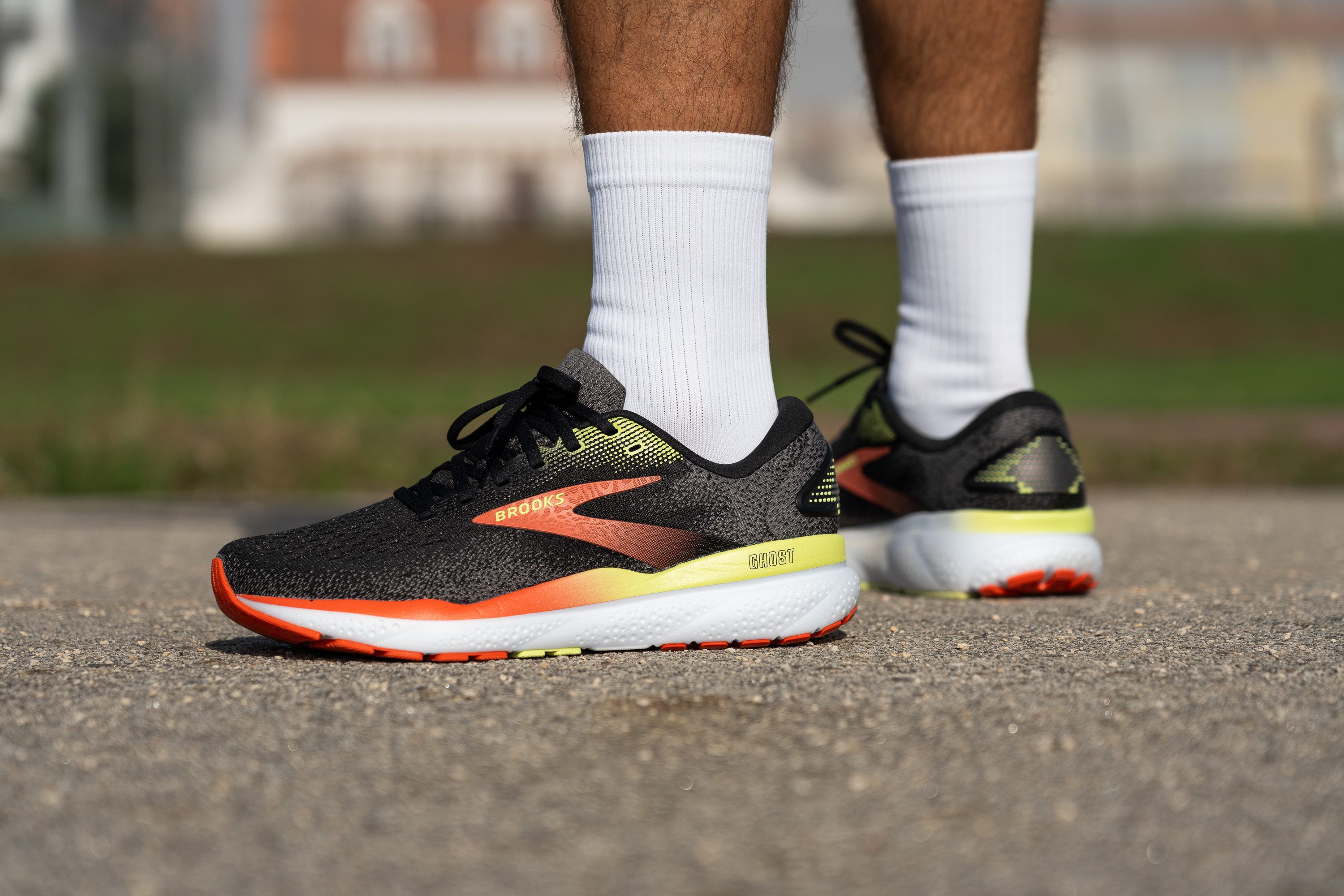
Who should NOT buy
We've tested the Ghost 16 extensively in our lab and found that its substantial heel-to-toe drop may not suit everyone—especially forefoot strikers who might find it limiting during their runs.
From our perspective, midfoot strikers might also find themselves on the edge, as the design doesn't cater particularly well to their needs either. We believe both types of runners would benefit more from exploring mid-drop options like the Nike Vomero 17 or the Saucony Ride 17, which offer a more balanced experience.
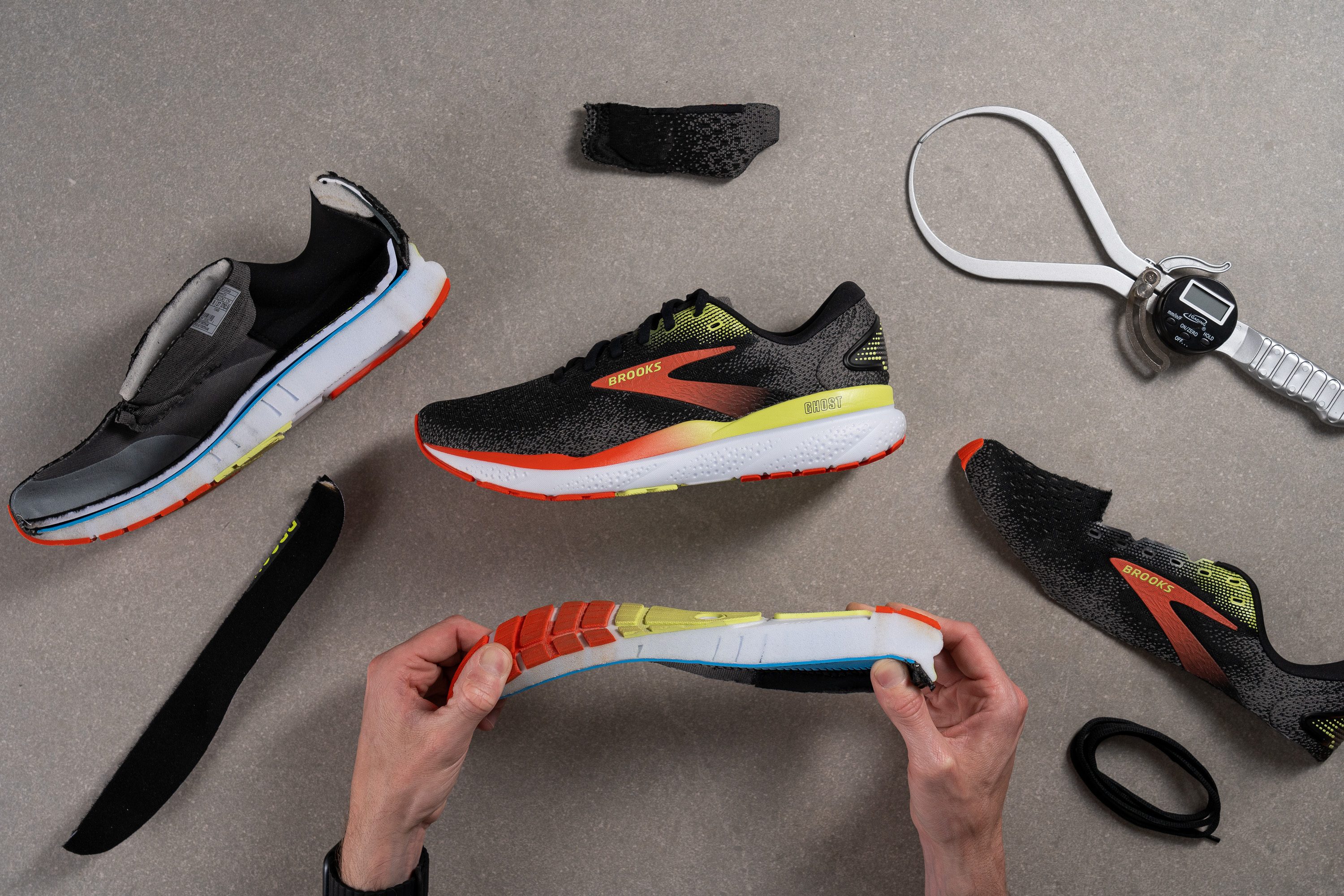
Furthermore, while we love that the Ghost 16 is a remarkably reliable shoe, it lacks a bit of the excitement that some runners seek in a modern daily trainer. In our experience, if you're looking for a shoe that prioritises fun over pure functionality, you might want to consider the ASICS Novablast 4 or the Hoka Mach 6.
Cushioning
Shock absorption
We found 133 SA of shock absorption in the heel, reflecting the current market trend: cushion-loaded daily trainers are now the norm, and what felt maximalist two years ago has become standard. On the flip side, the forefoot remains below average at just 92 SA, making it a solid choice for runners who enjoy more ground feel.
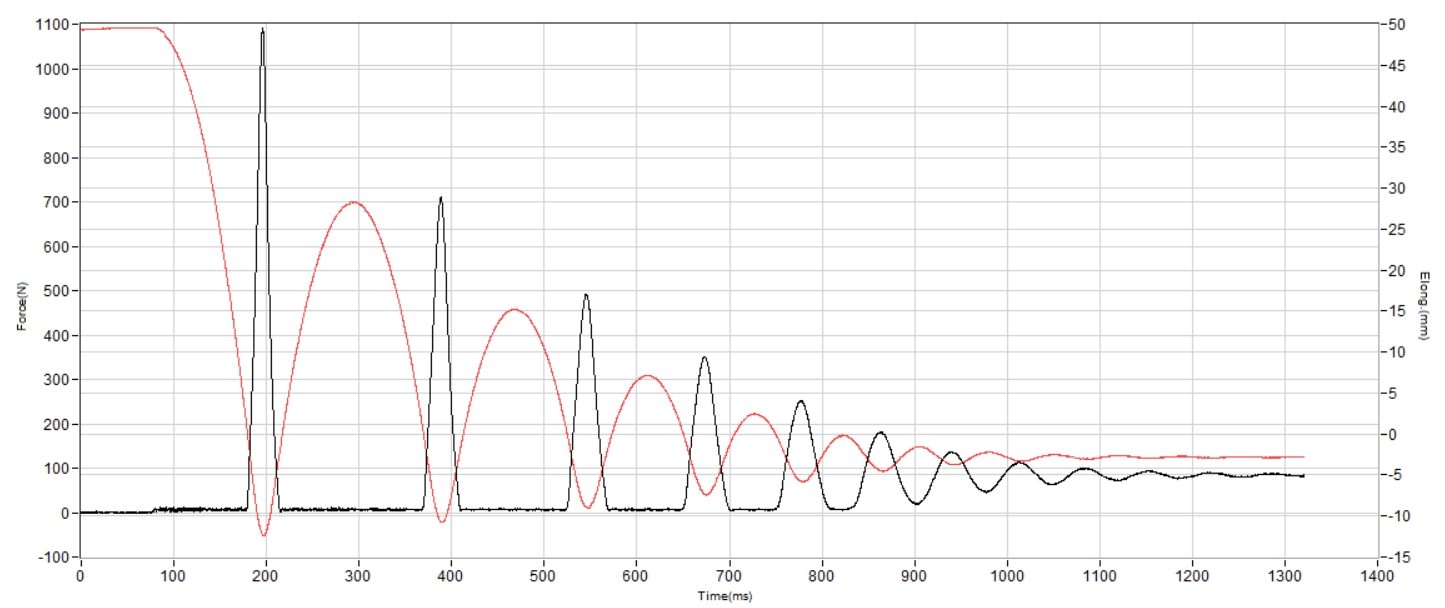
| Ghost 16 | 133 SA |
| Average | 129 SA |
Energy return
Coming from an underwhelming result in version 15, it was great to see this update boost energy return to 57.0% in the heel and 62.7% in the forefoot. The latter is especially promising as it finally crosses the 60% threshold, showing that Brooks is pushing the Ghost in the right direction.
| Ghost 16 | 57.0% |
| Average | 58.5% |
Heel stack
The Ghost 16 stands apart from the recent trend of maximalist running shoes and maintains a very similar stack height to the previous models.
Its 35.1 mm stack height provides ample cushioning for almost everyone, except perhaps those with a heavier build.

| Ghost 16 | 35.1 mm |
| Average | 34.8 mm |
Forefoot stack
In the forefoot, our measurements revealed a modest 22.8 mm stack height, which provides substantial ground feel during runs—take it or leave it.
From our tests, the Ghost 16 performs well for midfoot and forefoot strikers on short and easy runs. However, during longer runs, the cushioning might prove insufficient for all but the lightest of runners.
For those concerned about forefoot cushioning, we recommend considering the Hoka Clifton 9, which offers an additional 4 mm in this area at a similar price point.
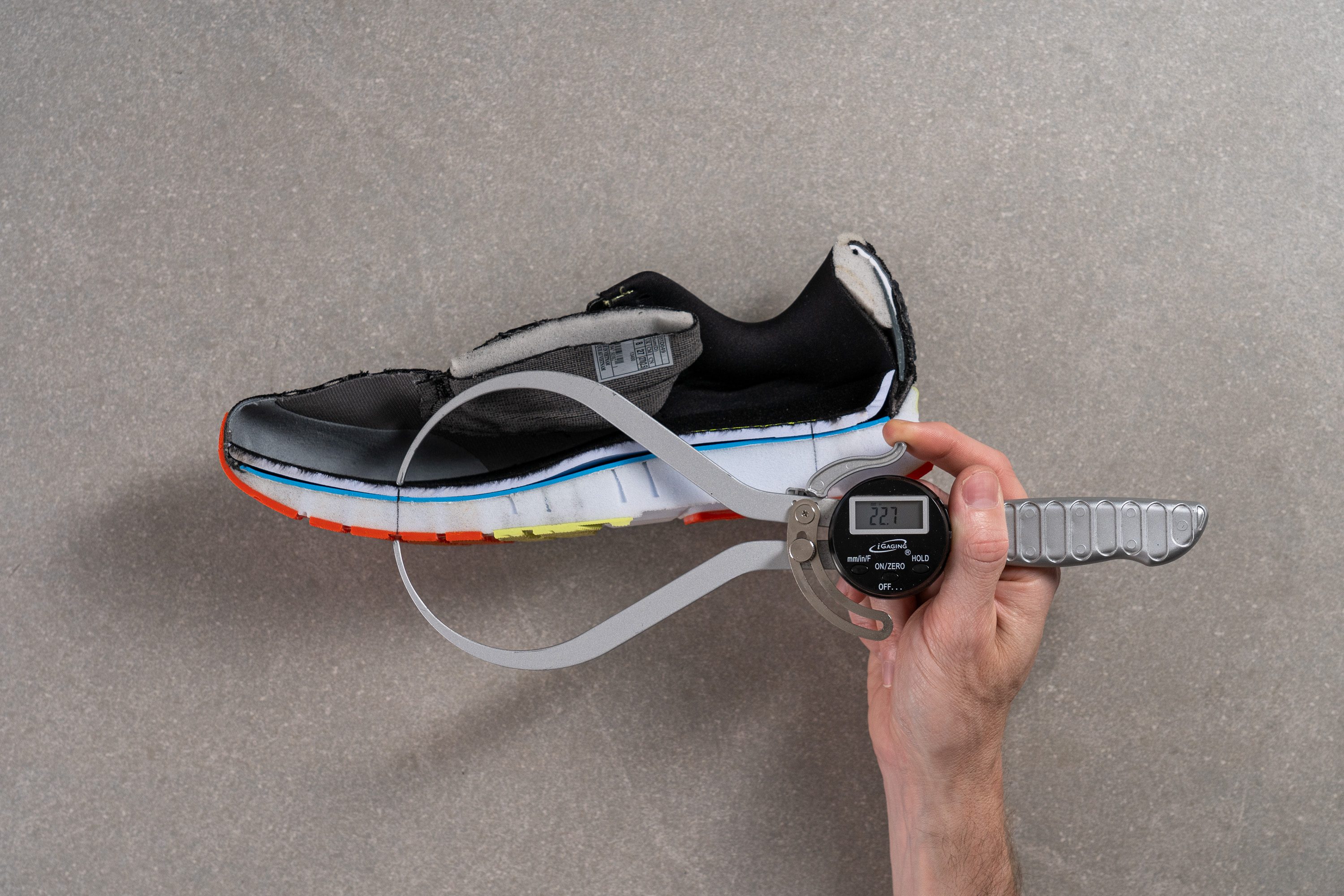
| Ghost 16 | 22.7 mm |
| Average | 26.2 mm |
Drop
The Ghost has long been the go-to high-drop daily trainer, and Brooks has no plans to alter this, knowing well that a change would disappoint its legion of loyal customers.
We measured a 12.4 mm drop from heel to toe, which is significant. This design particularly benefits heel strikers and those who often have calf issues. However, we believe it may be excessive for runners who strike the ground more forward.
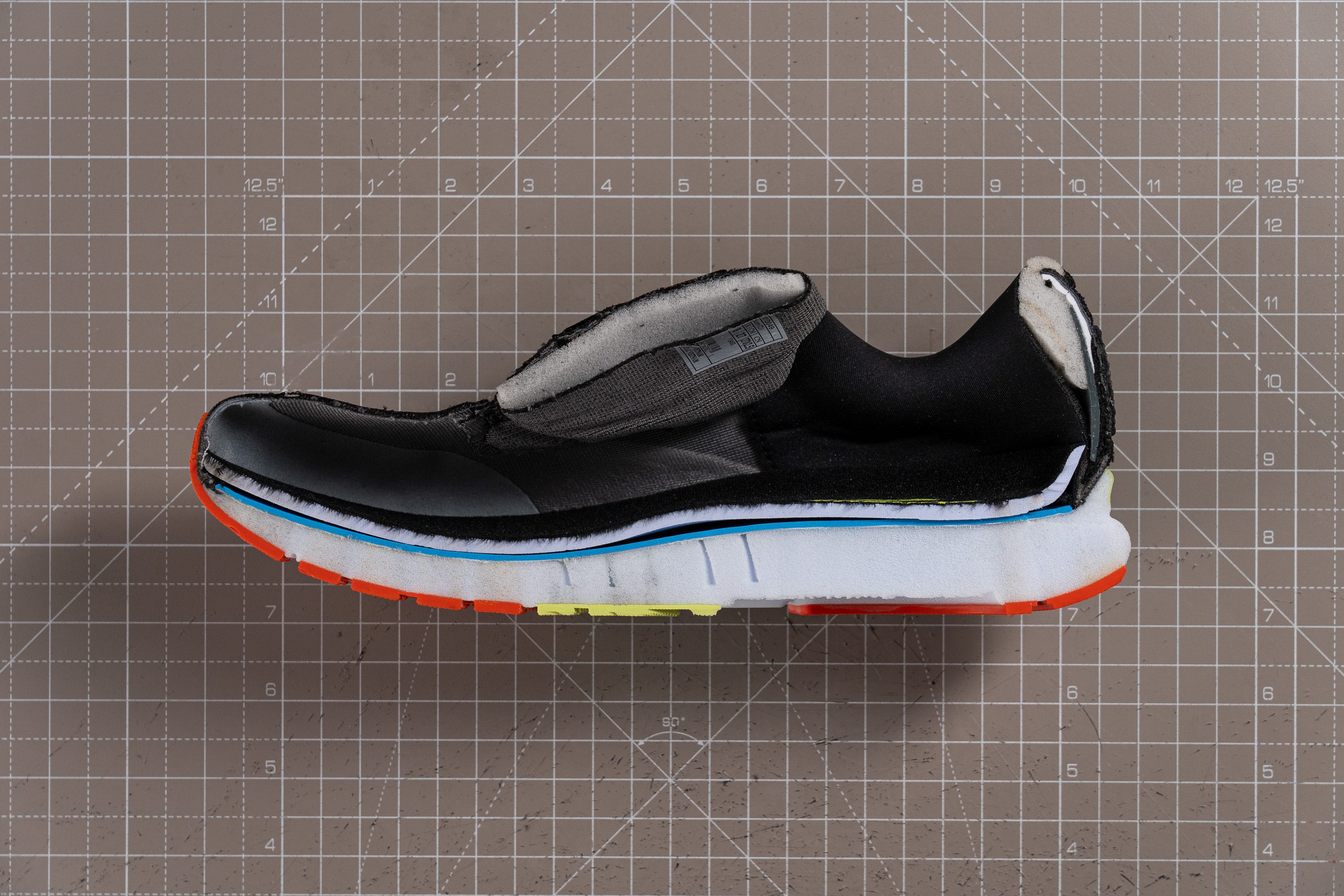
| Ghost 16 | 12.4 mm |
| Average | 8.6 mm |
Midsole softness
Last year, we expressed disappointment that Brooks continued using their older DNA Loft v2 in the Ghost series, despite having the more advanced DNA Loft v3 at their disposal, which offers enhanced bounce and responsiveness.
Fortunately, with the Ghost 16, Brooks has upgraded to the latest DNA Loft v3 foam. This new formulation, with its nitrogen-injected manufacturing process, delivers increased energy return and reduces weight compared to standard EVA.
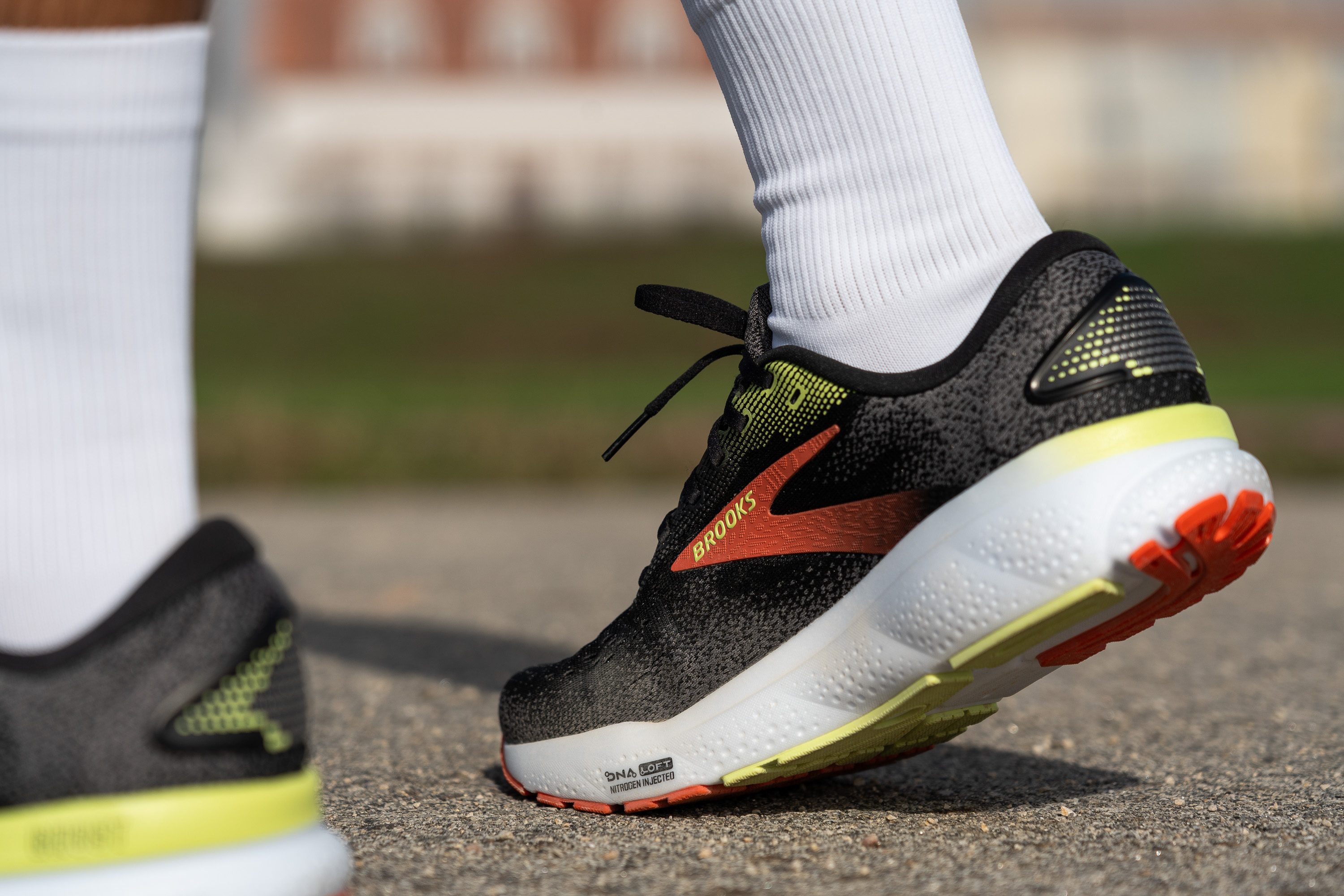
We also put the midsole to the test using our Shore A durometer after cutting the shoe in half. The results showed a balanced 21.6 HA, which strikes a perfect middle ground—not too plush, yet not overly firm either.
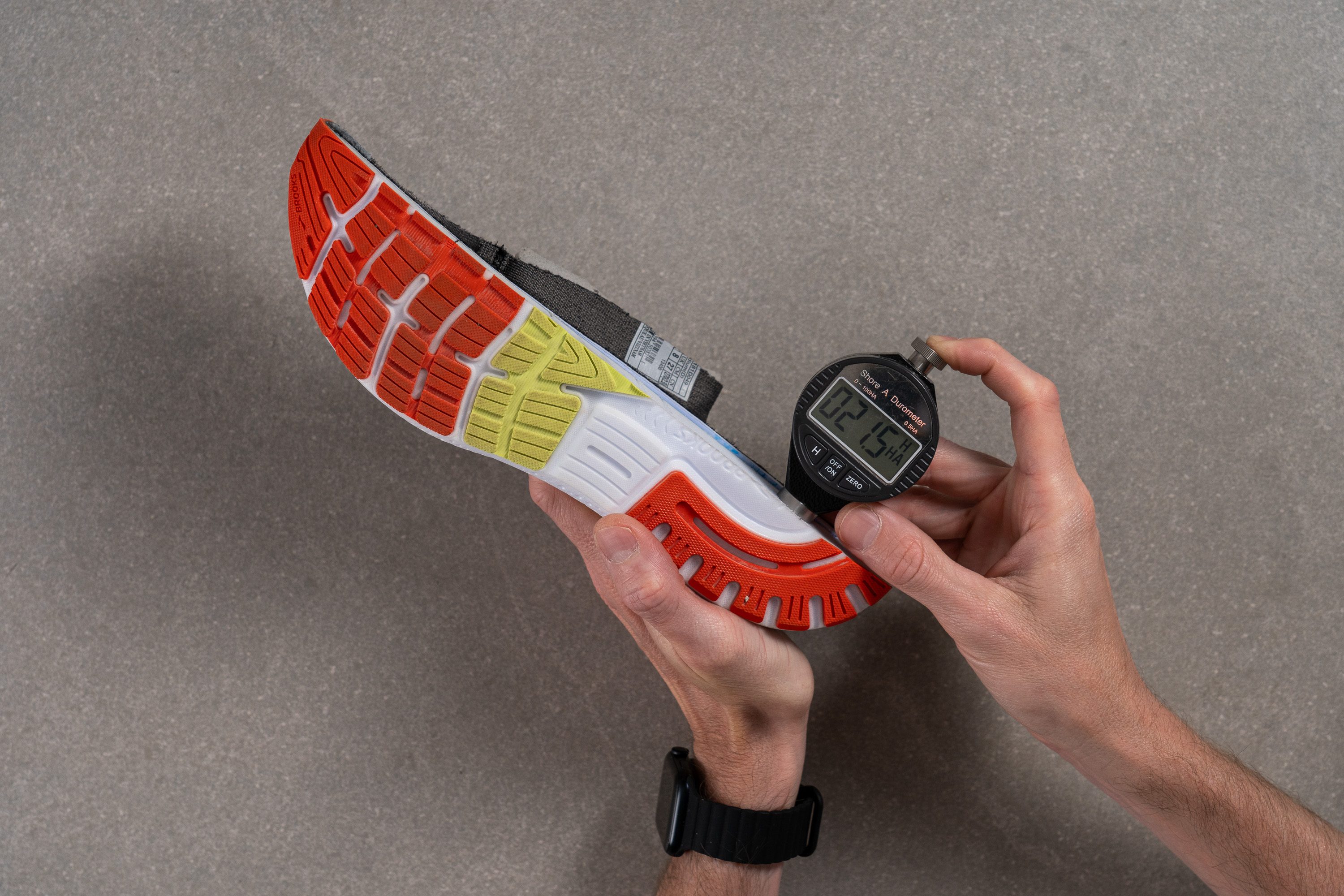
| Ghost 16 | 21.6 HA |
| Average | 20.4 HA |
Size and fit
Size
Brooks Ghost 16 fits true to size (2309 votes).
Width / Fit
From our perspective, after testing hundreds of shoes, we've observed a clear trend toward designing roomier running shoes in recent years—and we fully welcome it.
The Ghost 16 exemplifies this shift, measuring 96.1 mm at the widest part based on our custom gel mould. While this measurement is close to average, it offers slightly more room than previous generations and many other daily trainers.
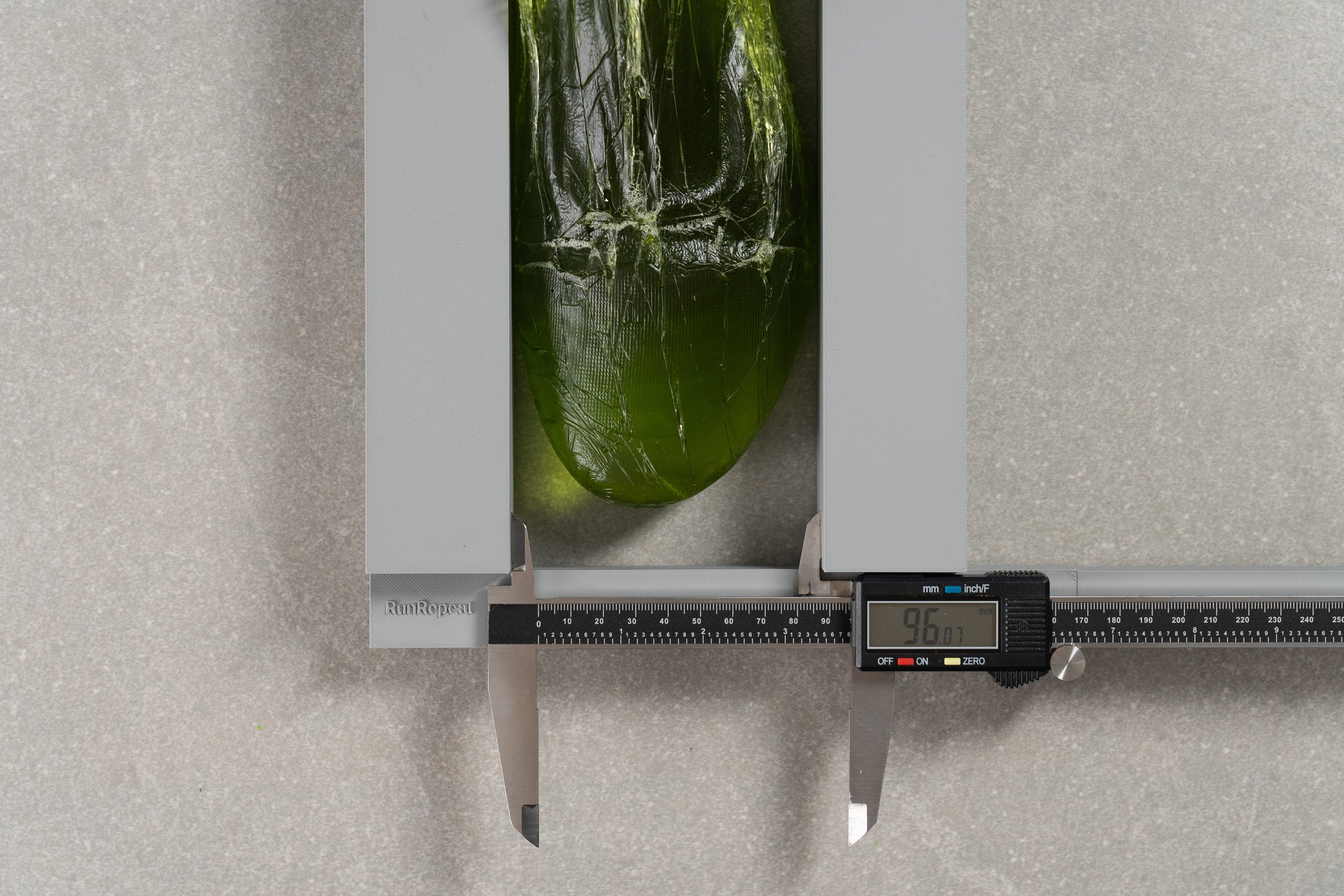
| Ghost 16 | 96.1 mm |
| Average | 95.1 mm |
Toebox width
On the flip side, the toebox retains a pointy design that, in our opinion, may not suit runners with wider feet. After testing, we discovered a measurement of 72.1 mm, which is slightly below average.
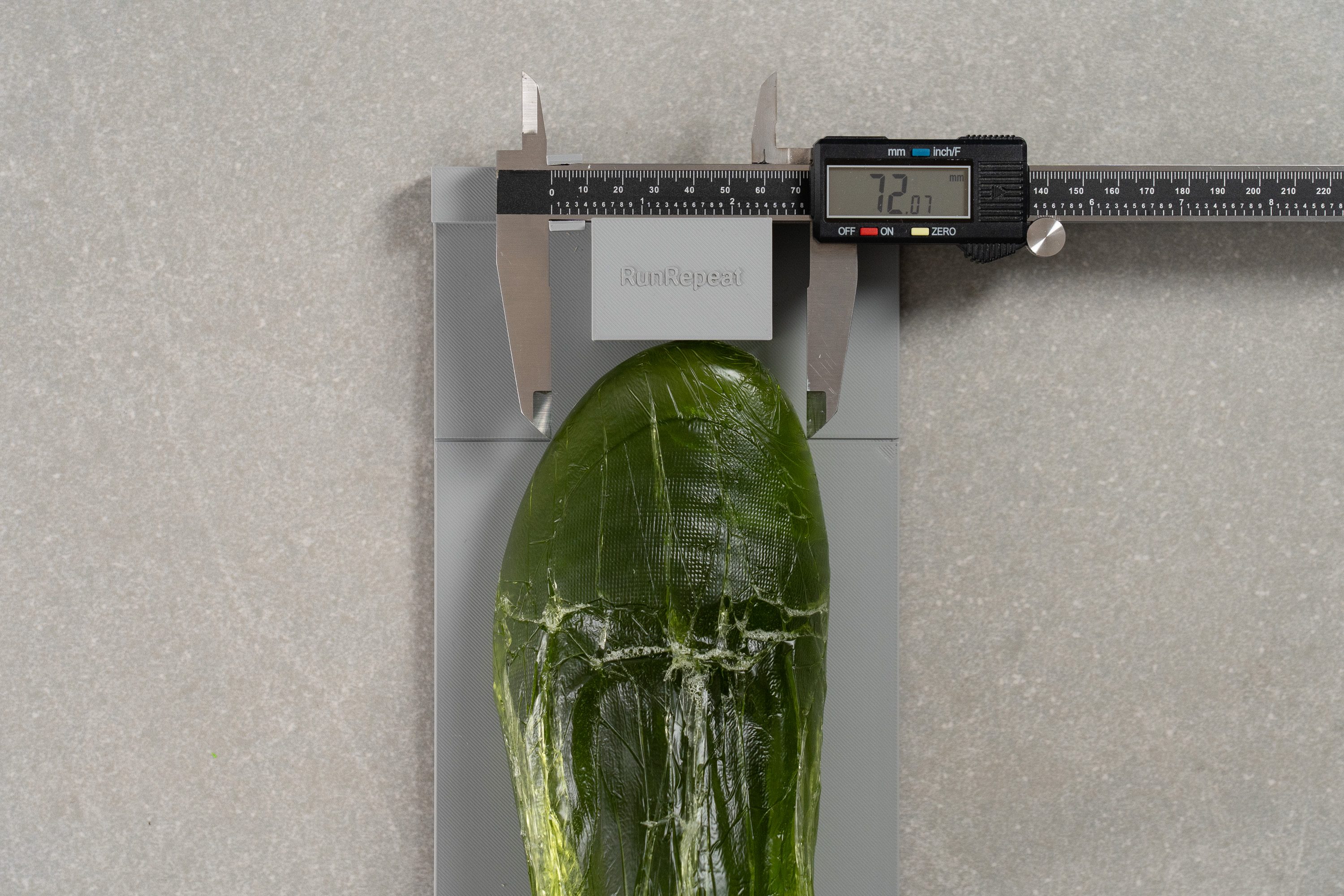
| Ghost 16 | 72.1 mm |
| Average | 73.2 mm |
Toebox height
After completing our width measurements, we used a vernier calliper to take the final one: toebox height.
The Ghost’s 26.8 mm offers a well-balanced height that suits most runners, though those with exceptionally high-volume feet may prefer exploring other options like the Adidas Supernova Rise.

| Ghost 16 | 26.8 mm |
| Average | 27.1 mm |
Traction / Grip
Traction test
As our SATRA TM144 grip test showed, the Ghost 16 offers great traction on both dry and wet pavements. With a forefoot friction score of 0.48, there is little-to-no risk of slipping or skidding as you push off the wet surface.
| Ghost 16 | 0.48 |
| Average | 0.48 |
Outsole design
The updates to the outsole are subtle, maintaining extensive coverage and featuring multiple cutouts to enhance flexibility and water drainage. Brooks calls it Segmented Crash Pad.

Flexibility / Stiffness
During our testing in the lab, when we flexed the shoe up to 30 degrees, it showcased excellent flexibility, requiring just 9.6N to bend.
We found that this is perfect for those who value a natural foot feel and for everyday activities such as walking or hitting the gym. Additionally, the Ghost 16 excels as a travel companion, perfectly suited for both city tours and morning runs.
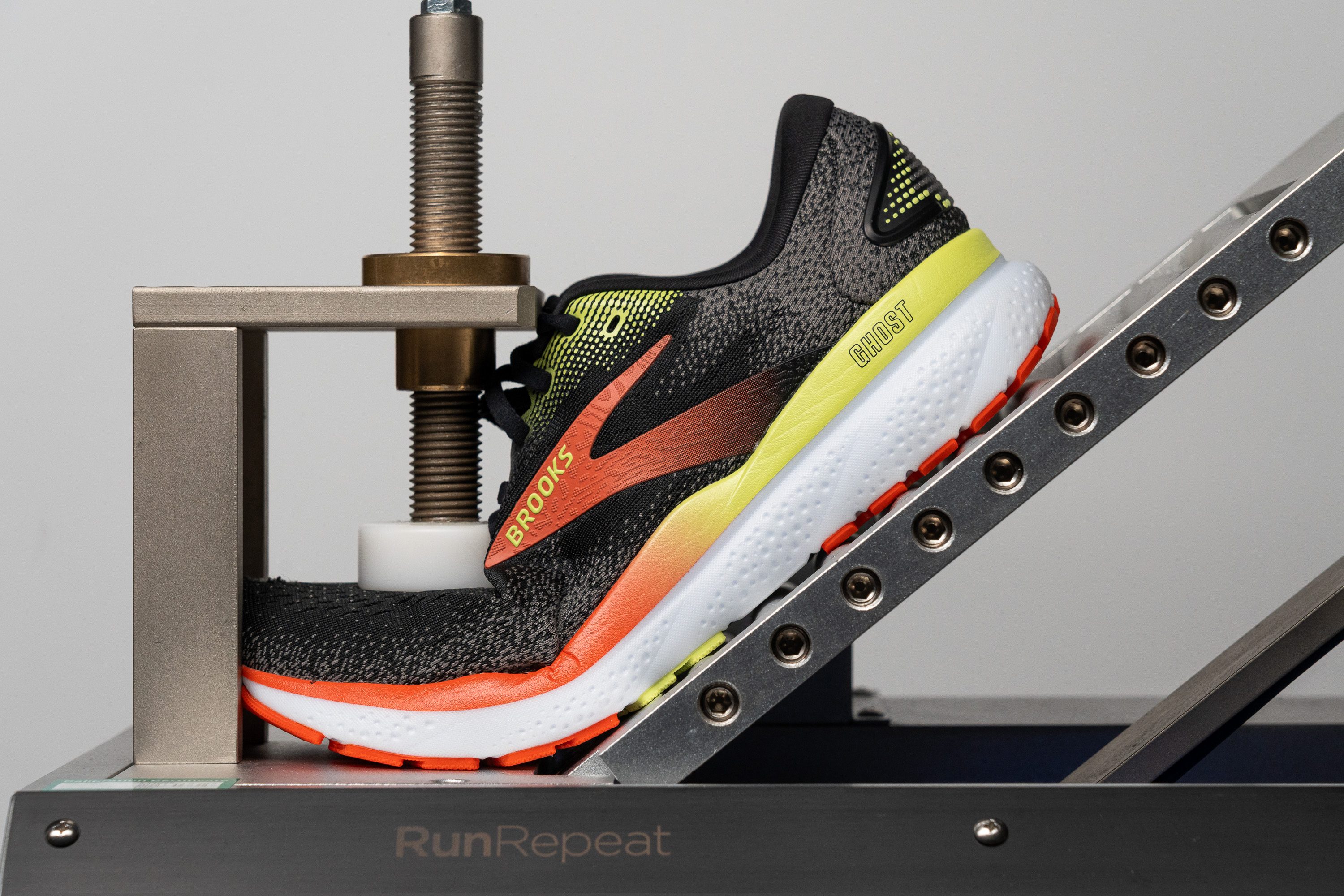
| Ghost 16 | 9.6N |
| Average | 15.3N |
Stiffness in cold (%)
After another 20-minute session in the freezer, we observed that the Ghost 16 became 32.5% stiffer. This increased stiffness will likely be noticeable to runners in colder climates.
| Ghost 16 | 33% |
| Average | 33% |
Weight
Fortunately, despite its thick outsole rubber, weight isn't an issue with this shoe. At just 9.4 oz or 266g, we consider it an ideal weight for a daily trainer. And it's 0.4 oz lighter than its predecessor.
On the other hand, less weight is always a plus if it doesn't compromise durability. And while we are quite pleased with this outcome, we think that a sub-9-oz Ghost would be simply amazing.
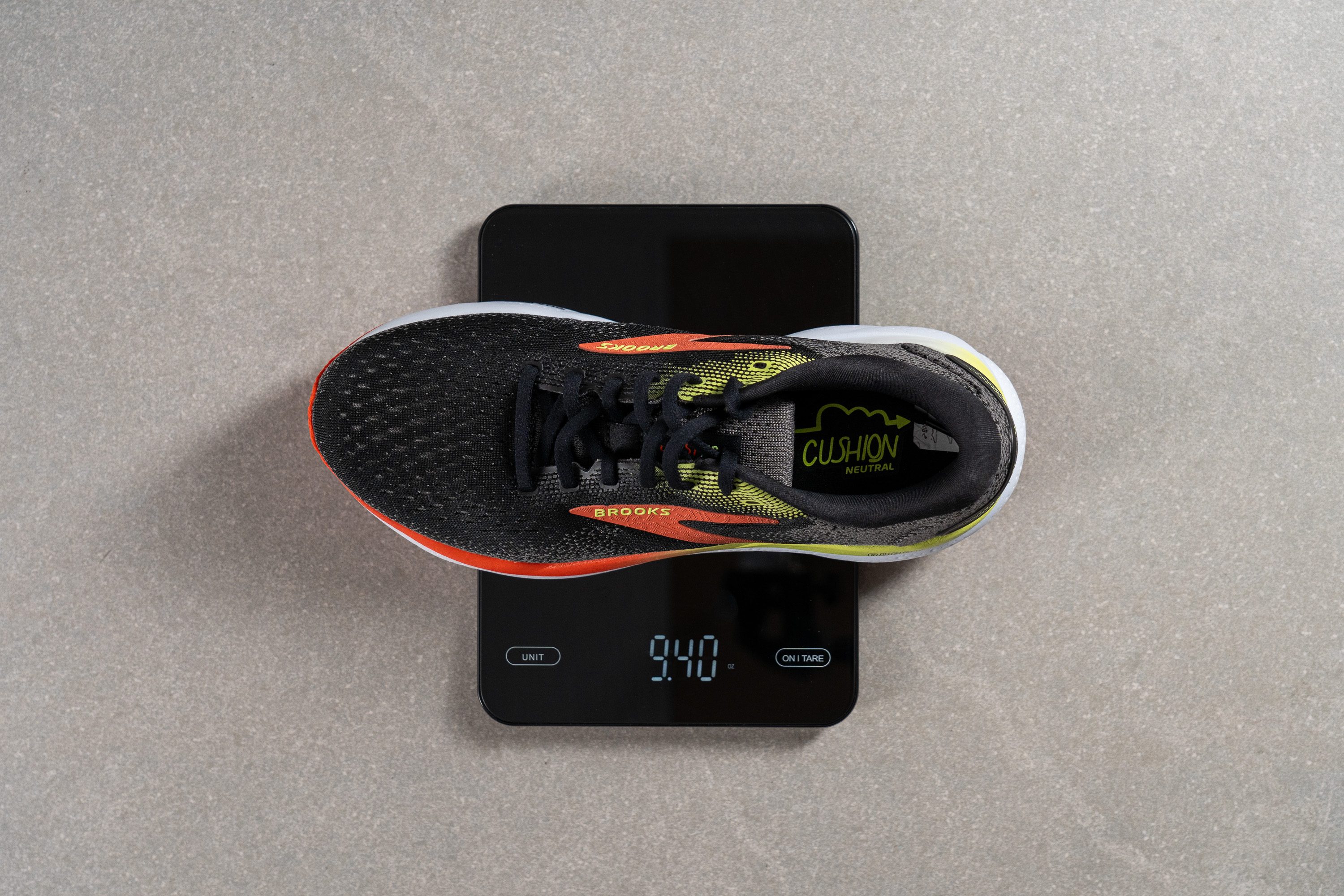
| Ghost 16 | 9.4 oz (266g) |
| Average | 9.3 oz (264g) |
Breathability
At first glance, the engineered mesh upper of the Brooks Ghost 16 appears highly breathable, featuring large ventilation holes throughout the toebox. To confirm its performance, we conducted many tests, starting with our smoke-pumping machine.
Our findings were positive, with the shoe scoring 4/5—our preferred rating for daily trainers. While those in extremely humid and hot climates—like the Philippines or Miami—may prefer a shoe with 5-out-of-5 ventilation, the Ghost 16's airflow makes it suitable for nearly all conditions.
Following the smoke test, we examined the structure of the upper with our light. The design strategy by Brooks is evident: a well-ventilated toebox combined with thicker sides to enhance both stability and ventilation.
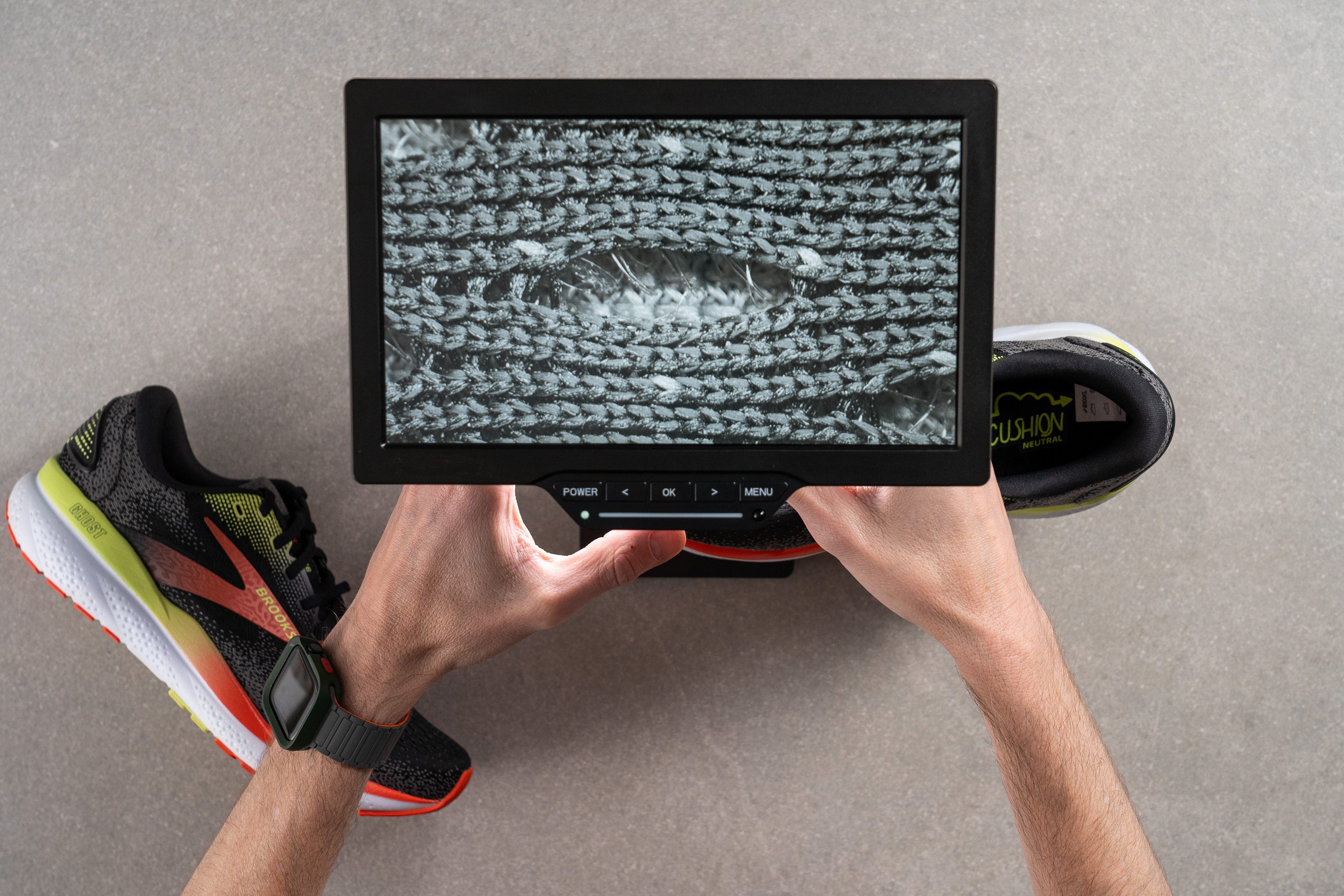
We then inspected the ventilation holes under a microscope, capturing stunning images as usual.
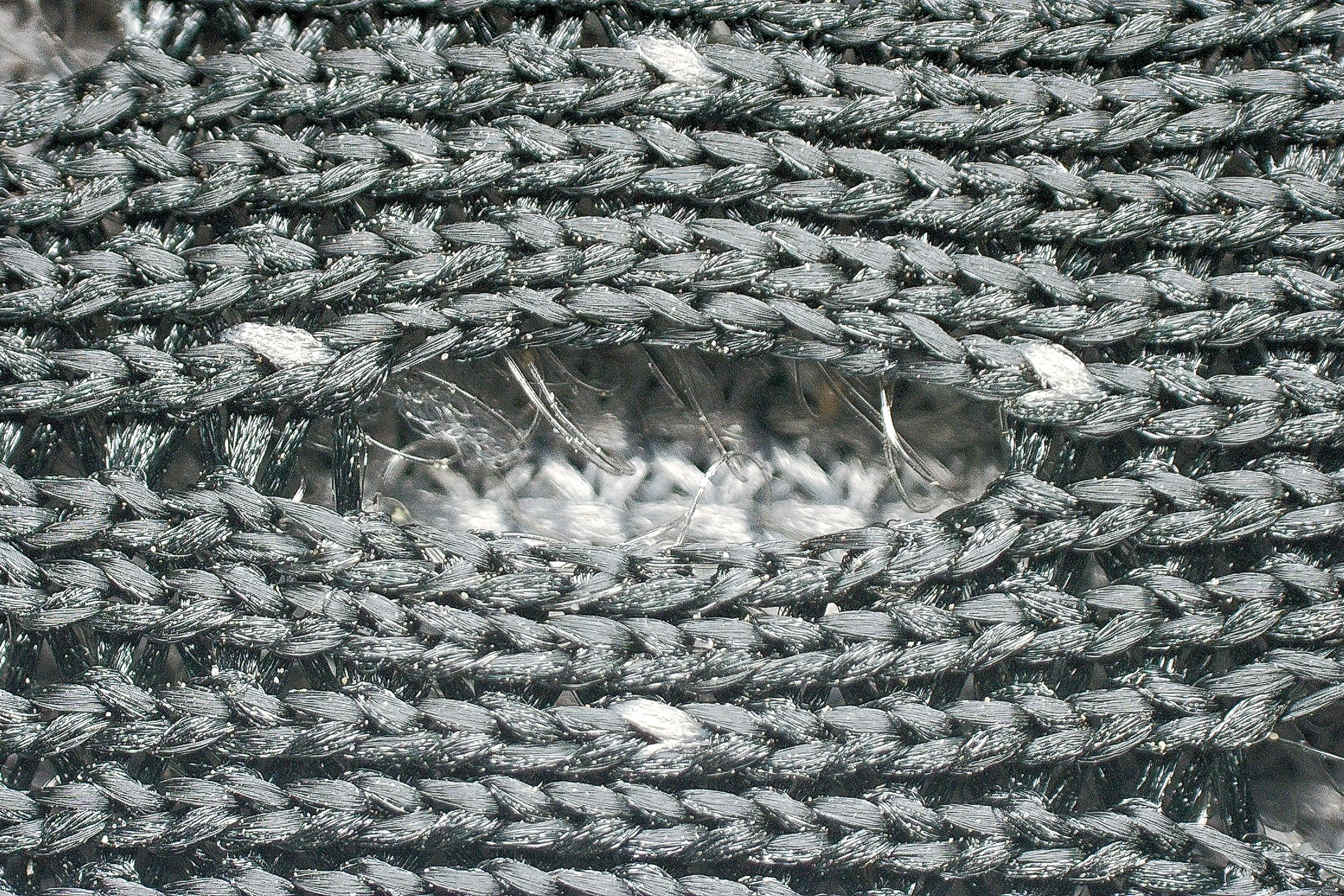
We discovered a classic engineered mesh that allows air to flow every few millimetres. And although a secondary layer slightly restricts airflow, it enhances overall comfort and should boost durability.
Overall, we are pleased with this upper. It may not excel in any one area, but it's a great all-rounder and is free from any significant issues, aligning well with what we expect from the Ghost series.
| Ghost 16 | 4 |
| Average | 3.7 |
Stability
Lateral stability test
While it lacks specific support elements and it's a neutral shoe, Brooks has designed the Ghost 16 with some mild stability features such as reinforced sidewalls, a thin forefoot, and a stiff heel counter.
These additions make it suitable for light pronators who require just a hint of support, and that's why we believe Brooks is not offering a GTS version in this series like they do with the Glycerin or Adrenaline.
Torsional rigidity
We found that the Ghost 16 offers a balanced level of torsional rigidity. It's not ultra-flexible like a Vapour Glove 6, nor is it as stiff as an ASICS Superblast 2. This moderate flexibility aligns perfectly with its role as a daily trainer, providing just the right amount of support and adaptability for everyday use.
| Ghost 16 | 3 |
| Average | 3.5 |
Heel counter stiffness
We discovered that the stiffness of the heel counter is similar to those found in stability shoes with a 5/5, offering impressive firmness and better suited for heel strikers as it helps guide the feet straight.
Fortunately, Brooks has generously padded this area to prevent irritation commonly associated with ultra-rigid heel counters. Otherwise it would have been a real dealbreaker for us.
| Ghost 16 | 5 |
| Average | 2.9 |
Midsole width - forefoot
We used our callipers to measure the dimensions of the shoe, starting with the forefoot.
Our findings indicate that Brooks continues to embrace a conventional approach, keeping the Ghost firmly within the average range. The forefoot measures 115.0 mm at its widest point, exemplifying a classic, risk-averse strategy for a standard shoe like no other.
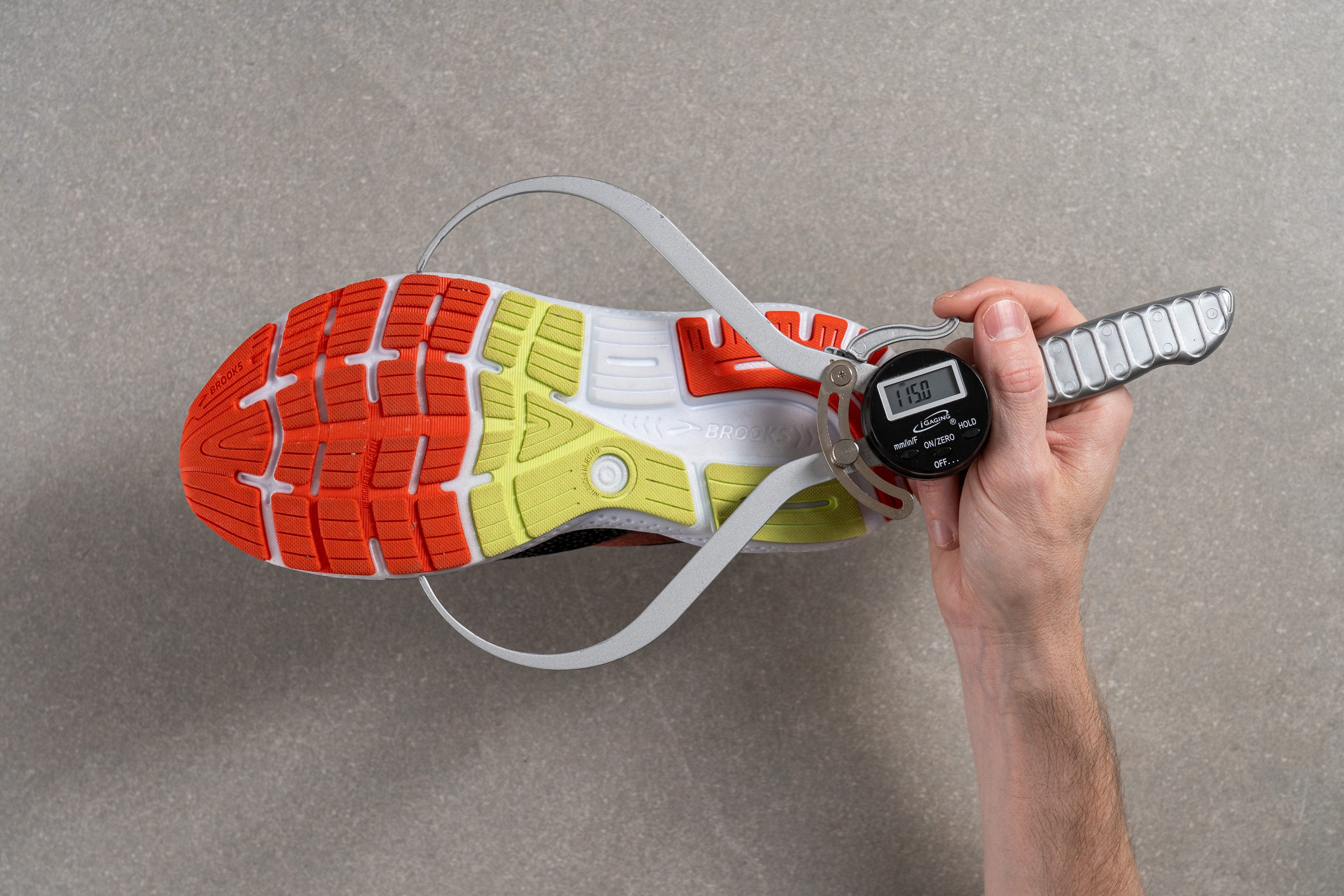
| Ghost 16 | 115.0 mm |
| Average | 114.4 mm |
Midsole width - heel
We then measured the heel, and we found a width of 94.7 mm—quite wide and logically designed.
Considering the shoe's high drop and super-stiff heel counter, a wider rearfoot area makes sense. This design choice again benefits heel strikers, aligning well with the typical needs of a classic Ghost runner.
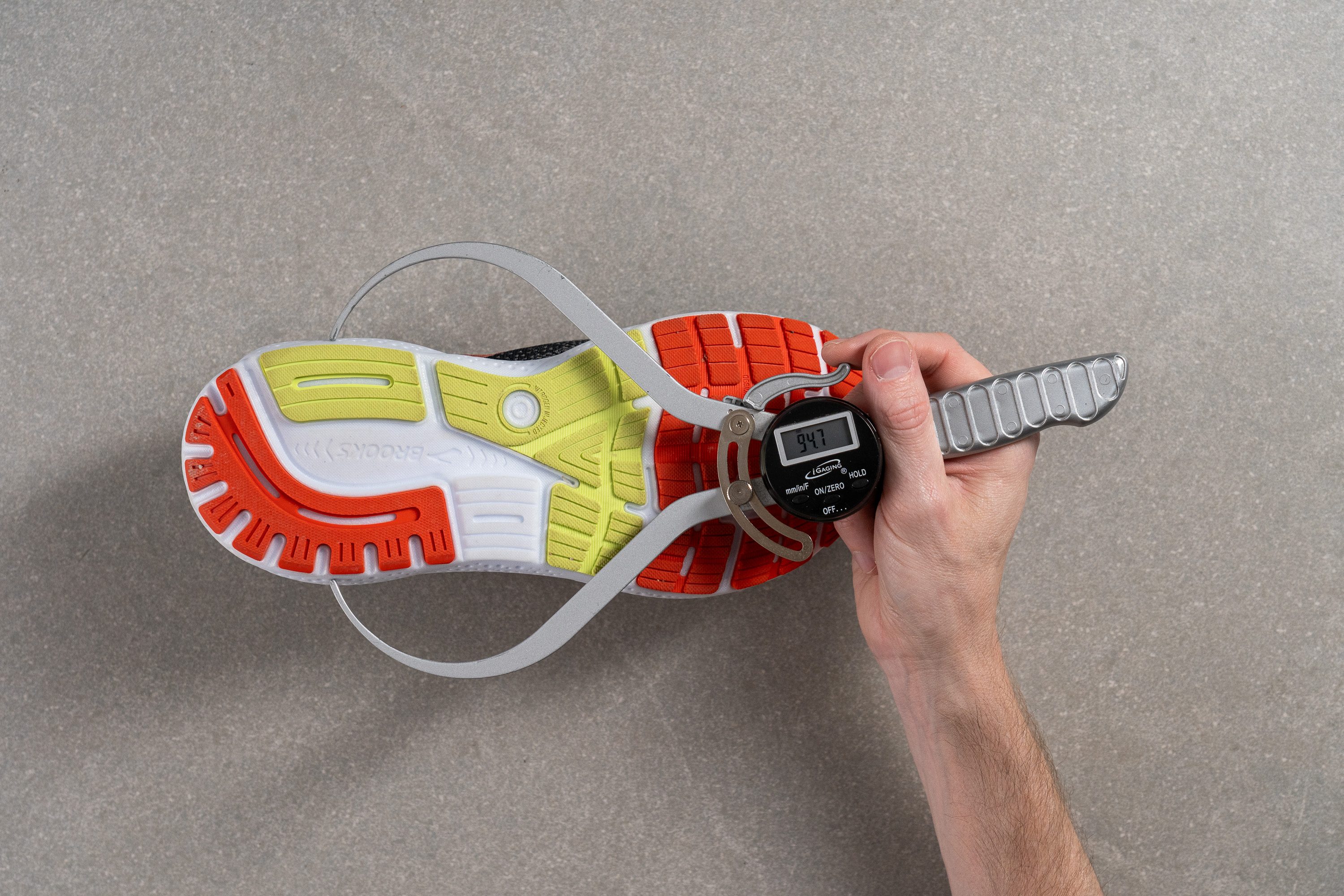
| Ghost 16 | 94.7 mm |
| Average | 90.7 mm |
Durability
Toebox durability
One concern with punched ventilation holes is their potential to compromise durability, and the Ghost 16 packs a bunch of them.
Despite our initial scepticism, when we tested the Ghost 16 with the Dremel, it performed well, earning a solid 3/5 in our assessment.
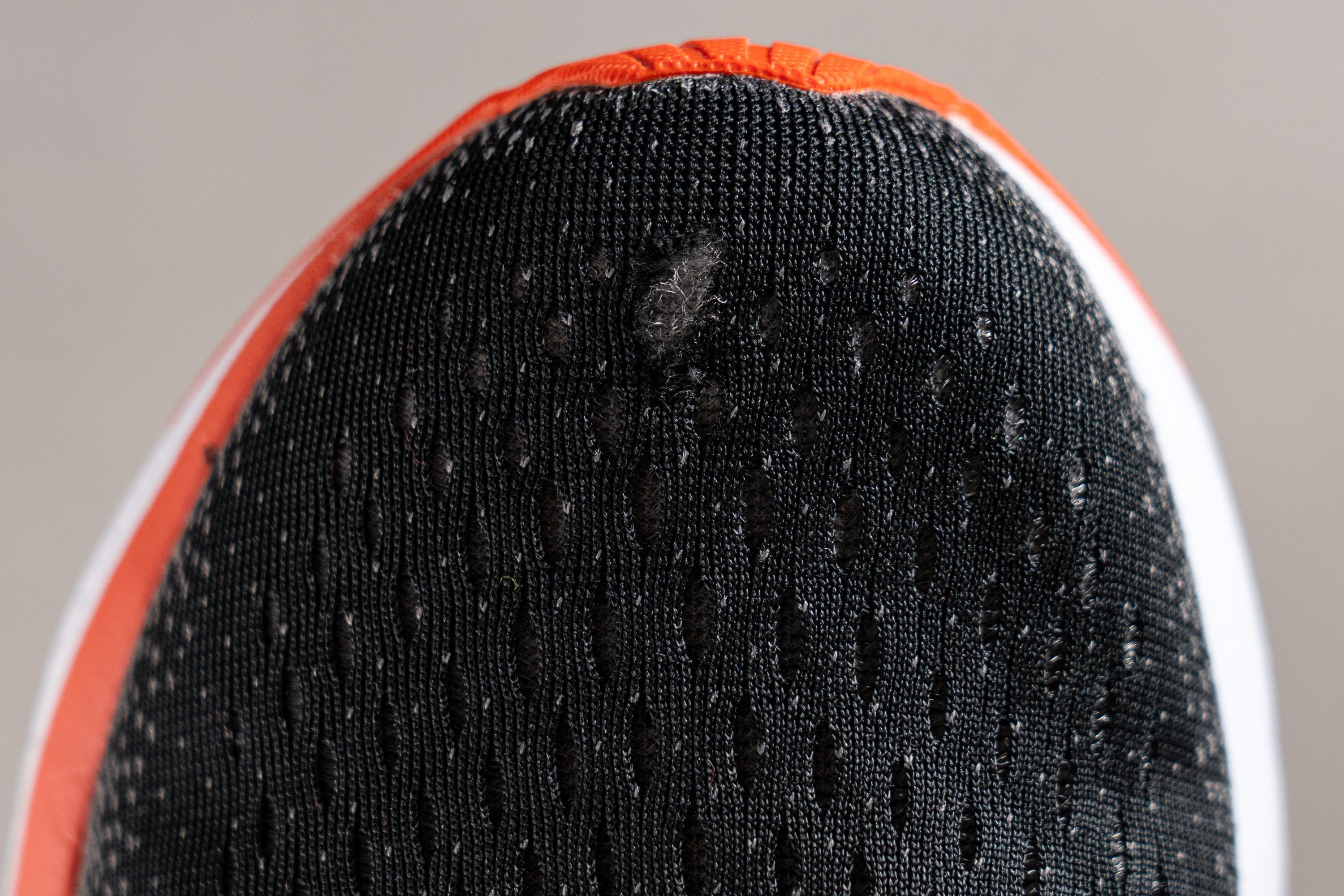
| Ghost 16 | 3 |
| Average | 2.6 |
Heel padding durability
A significant concern for many runners is the Achilles padding in their brand-new shoes.
In our lab, the Ghost 16's Achilles area underwent a second Dremel test and scored a nice 4/5. Based on our experience, it's highly unlikely that runners will experience premature wear in this regard.
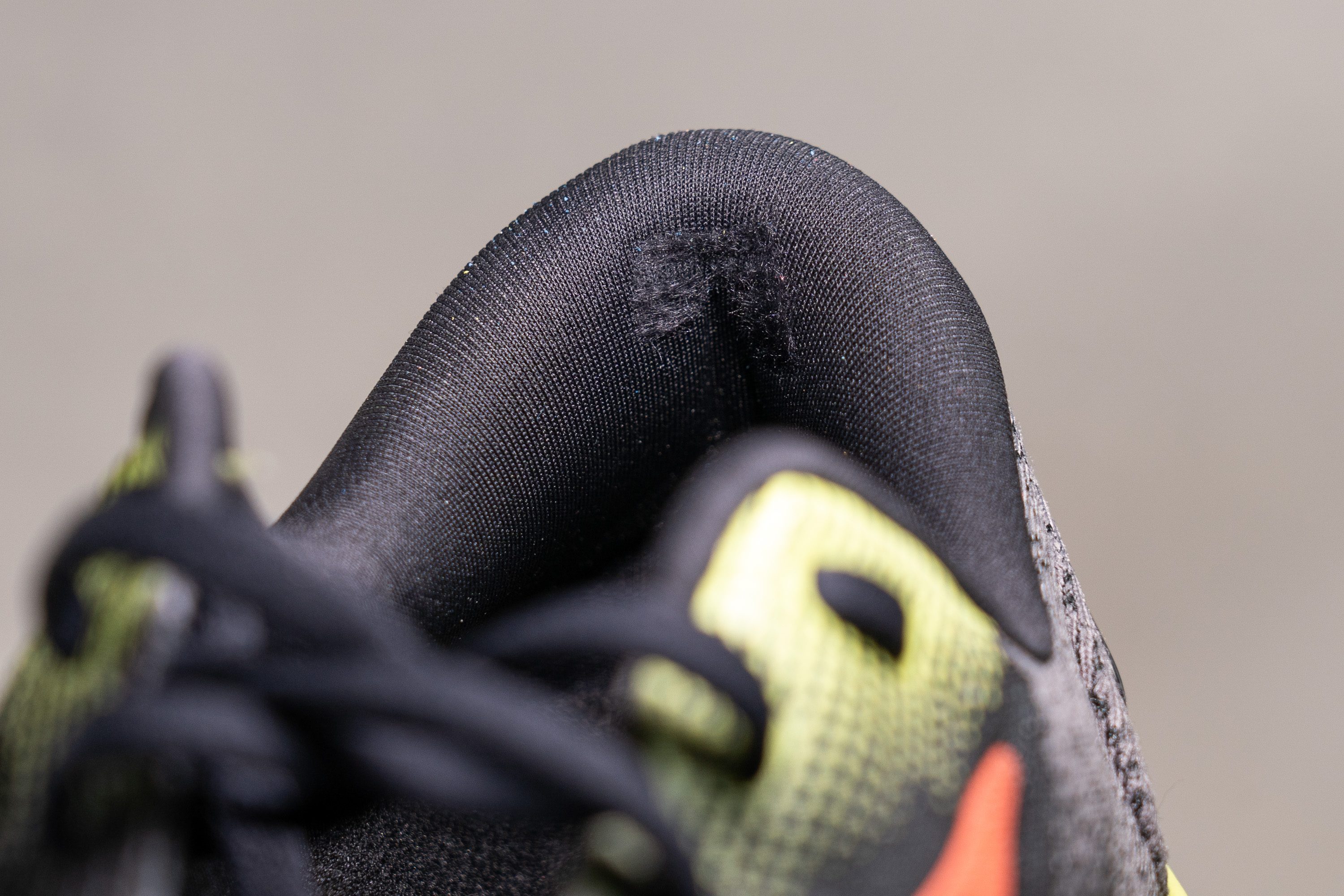
| Ghost 16 | 4 |
| Average | 3.4 |
Outsole hardness
We've already established that the upper is durable and well-ventilated, but for this shoe to truly be a workhorse, the outsole must also perform. Does it deliver?

To find out, we tested the hardness of the rubber. Unsurprisingly, the Ghost 16 is just average with a rating of 80.9 HC, demonstrating its straightforward, no-frills approach. And we also found traction to be adequate in both roads and dirt paths.
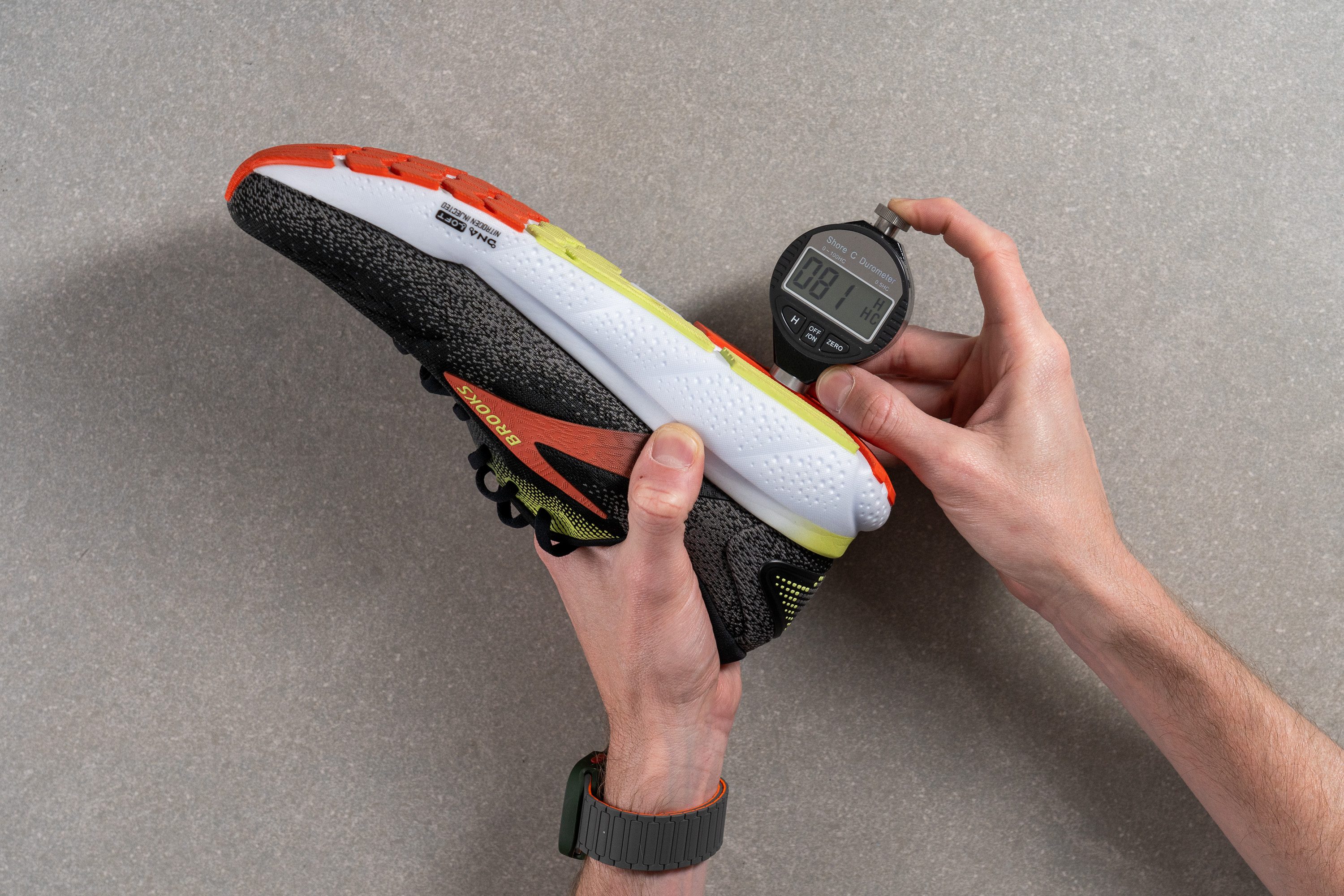
| Ghost 16 | 80.9 HC |
| Average | 79.2 HC |
Outsole durability
Eager to determine the resilience of this average rubber, we conducted a third Dremel test to assess its wear resistance.
We were pleased to find that the rubber used by Brooks held up exceptionally well, showing a minimal indentation of only 0.7 mm.
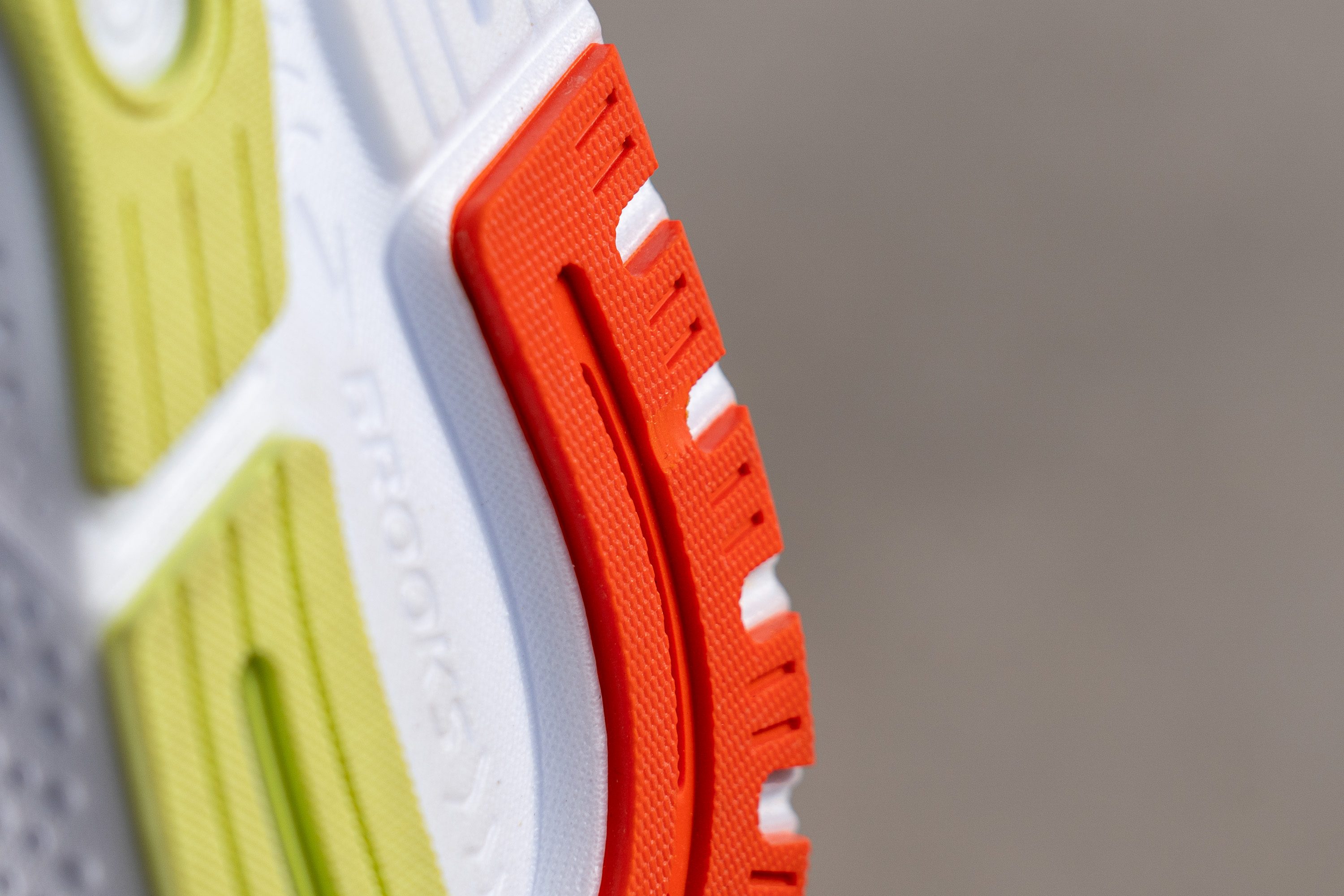
| Ghost 16 | 0.7 mm |
| Average | 1.1 mm |
Outsole thickness
To conclude our analysis of the outsole, we utilised our vernier calliper to measure the thickness of the rubber.
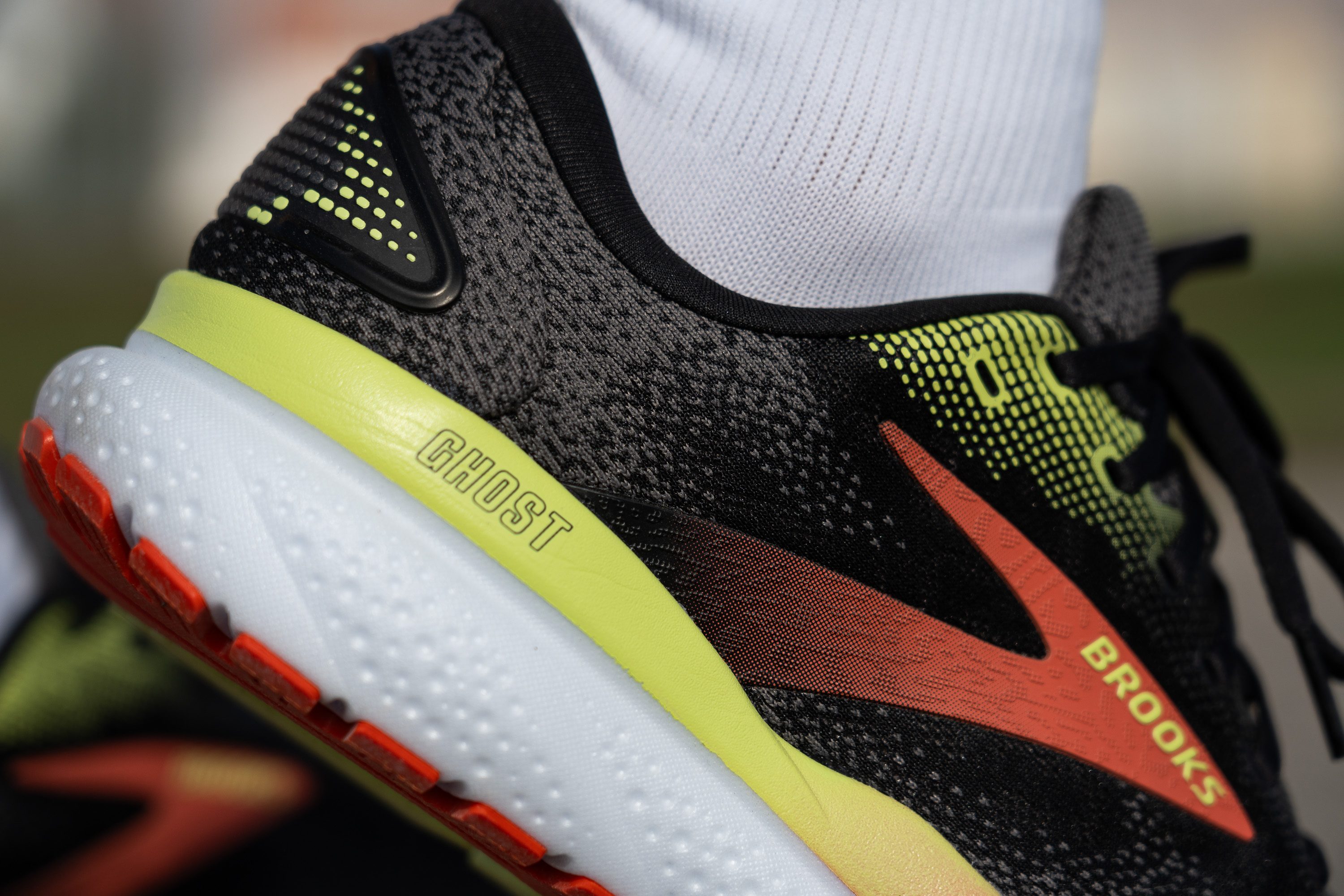
We discovered a thickness of 4.1 mm, which seems excessive to us. Even for those surpassing 600 or 700 miles in these shoes, we think there will be plenty of rubber left.
In fact, for the v17, we suggest that Brooks could reduce the thickness by at least 1 mm to make the Ghost lighter without any significant drawbacks.
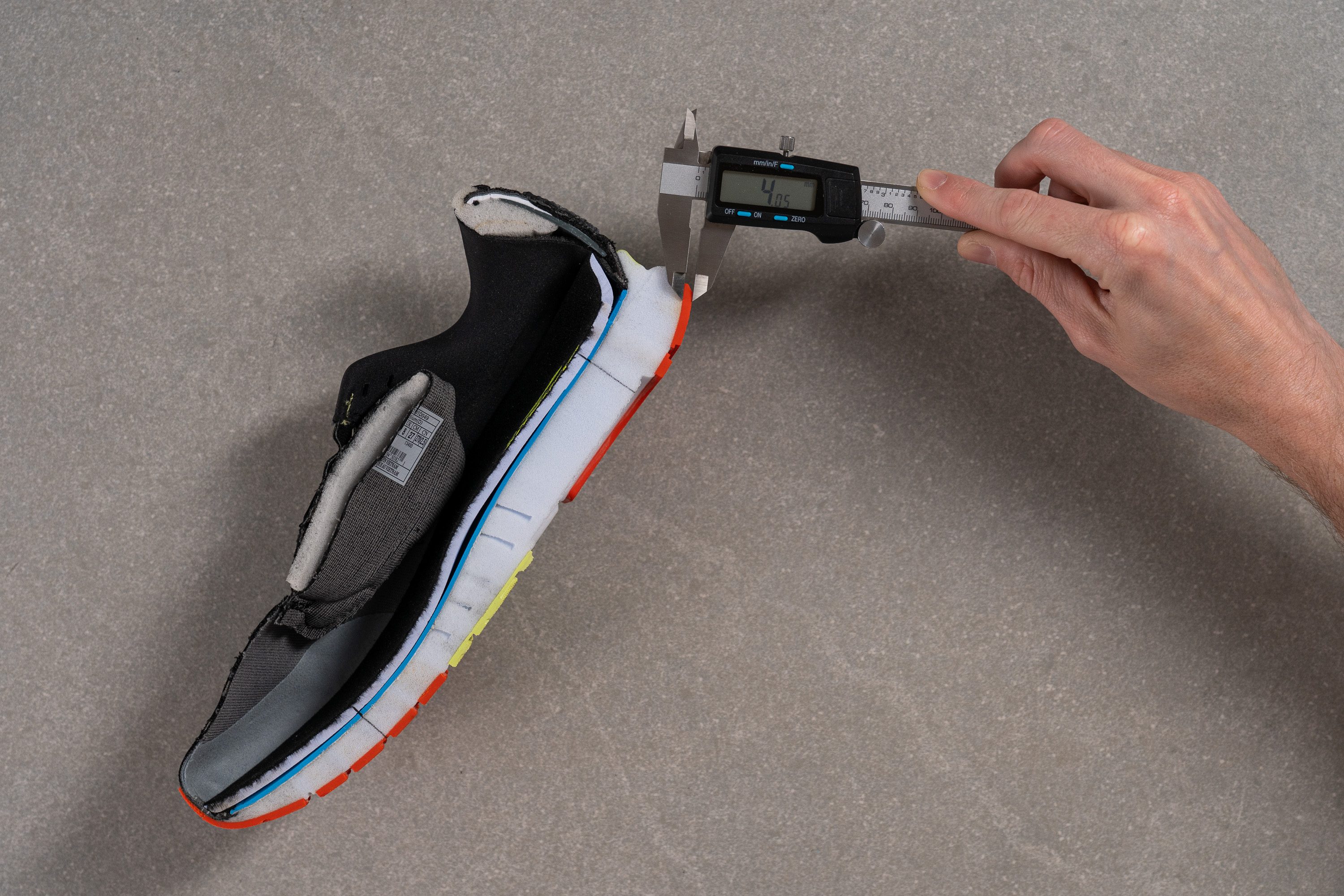
| Ghost 16 | 4.1 mm |
| Average | 3.2 mm |
Misc
Insole thickness
We measured the insole of the Ghost 16 and found it boasts a thickness of 5.0 mm, a minor increase from the previous model's 4.5 mm.

| Ghost 16 | 5.0 mm |
| Average | 4.5 mm |
Removable insole
We found that the insole is pretty basic and not glued to the last, allowing you to easily swap it with aftermarket orthotics if necessary.
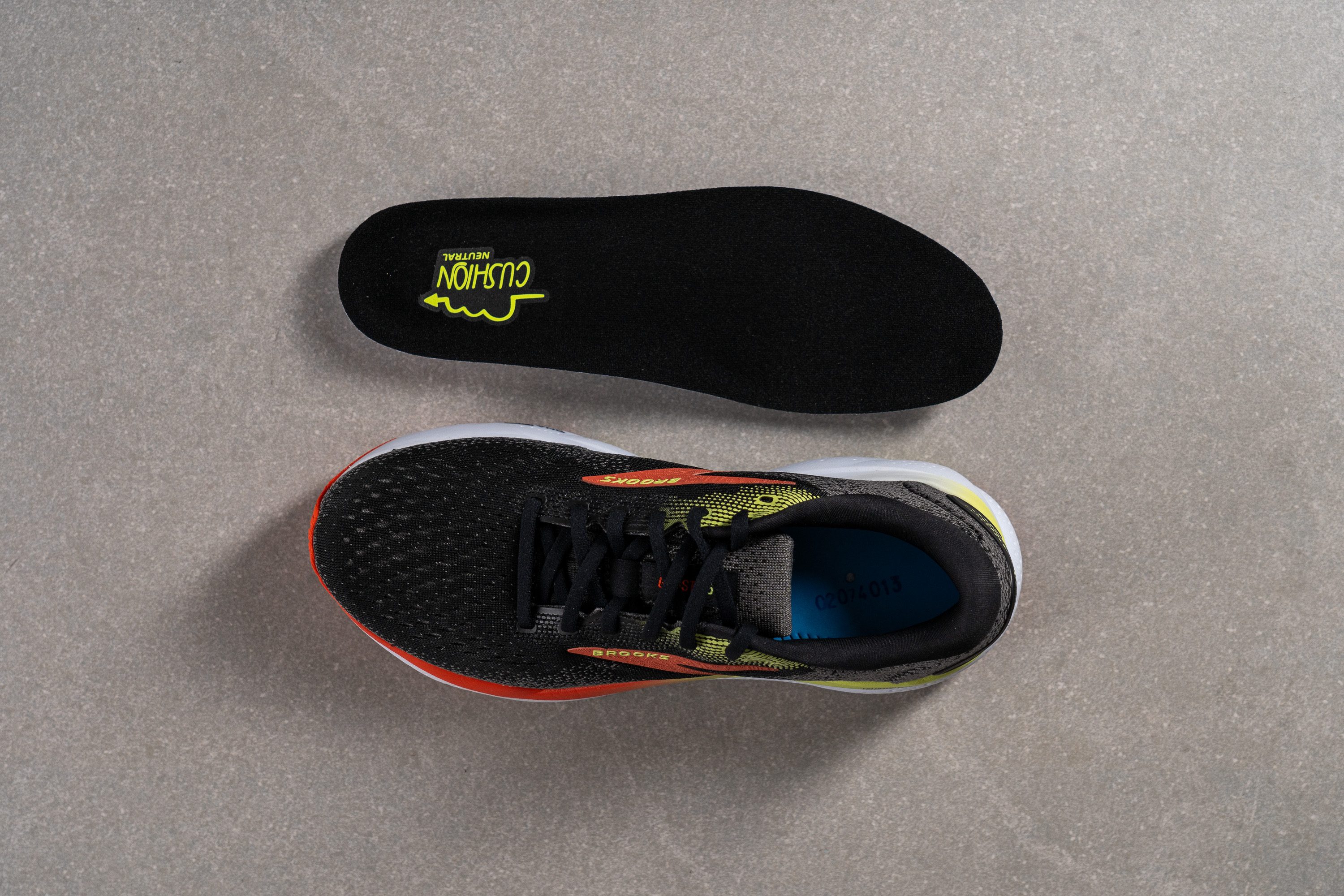
| Ghost 16 | Yes |
Midsole softness in cold (%)
DNA Loft v3 offers several enhancements over DNA Loft v2, including significantly improved performance in cold temperatures. In our lab tests, the Ghost 16 only became 16.2% firmer after spending 20 minutes in the freezer, compared to the 54.4% hardening observed in the v15.
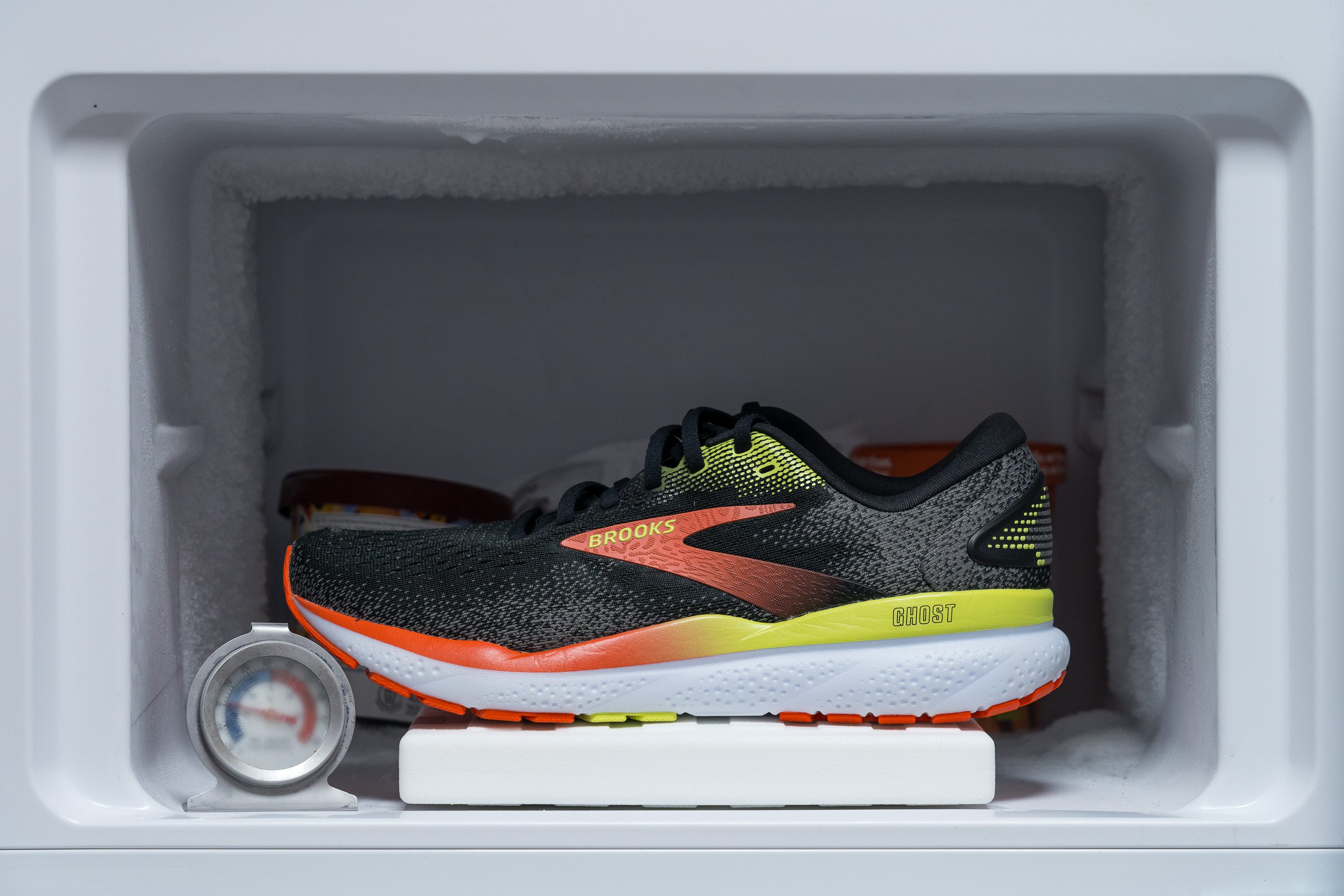
| Ghost 16 | 16% |
| Average | 24% |
Reflective elements
We love running shoes with 360-reflectivity, but we admit that's rare. Because of that, we are usually happy if we get reflective elements on the heel. It's the main spot for increasing safety, allowing the shoes to glow in the dark to cars and motorbikes coming from behind.
The Ghost 16 ticks this box and earns our seal of approval for night runs.
| Ghost 16 | Yes |
Tongue padding
The tongue of the Ghost 16 is a dream come true for those who appreciate a fluffy, plush instep area. We measured a generous 10.4 mm of foam from a single slab, a feature more commonly found in pricier daily trainers than in a £140 workhorse.
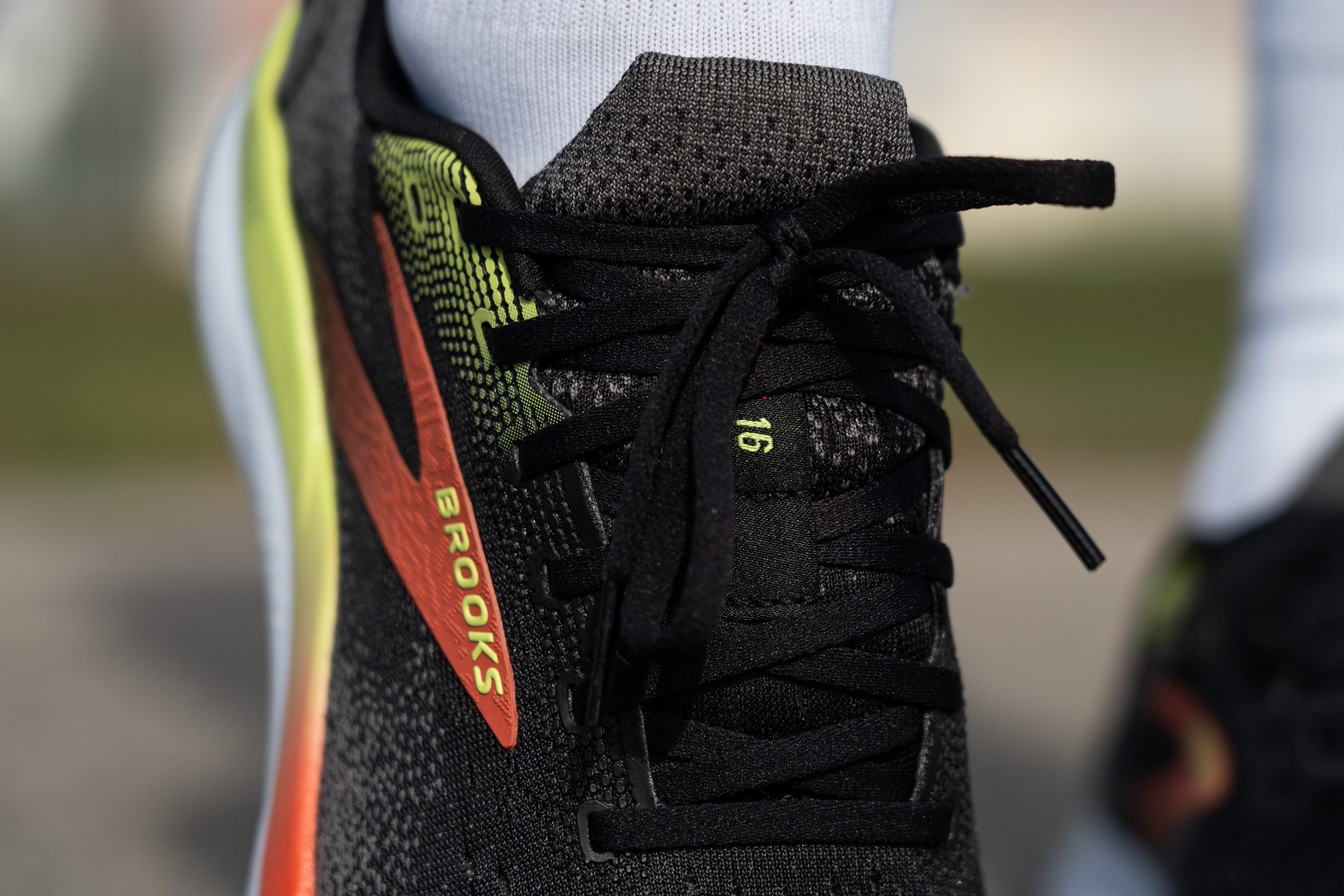
We also discovered that Brooks embraced a no-risk strategy with the lacing system—simple punched eyelets. In our view, this is the ideal approach for a daily trainer, as it's straightforward and effective. There's no need to reinveint the wheel here!
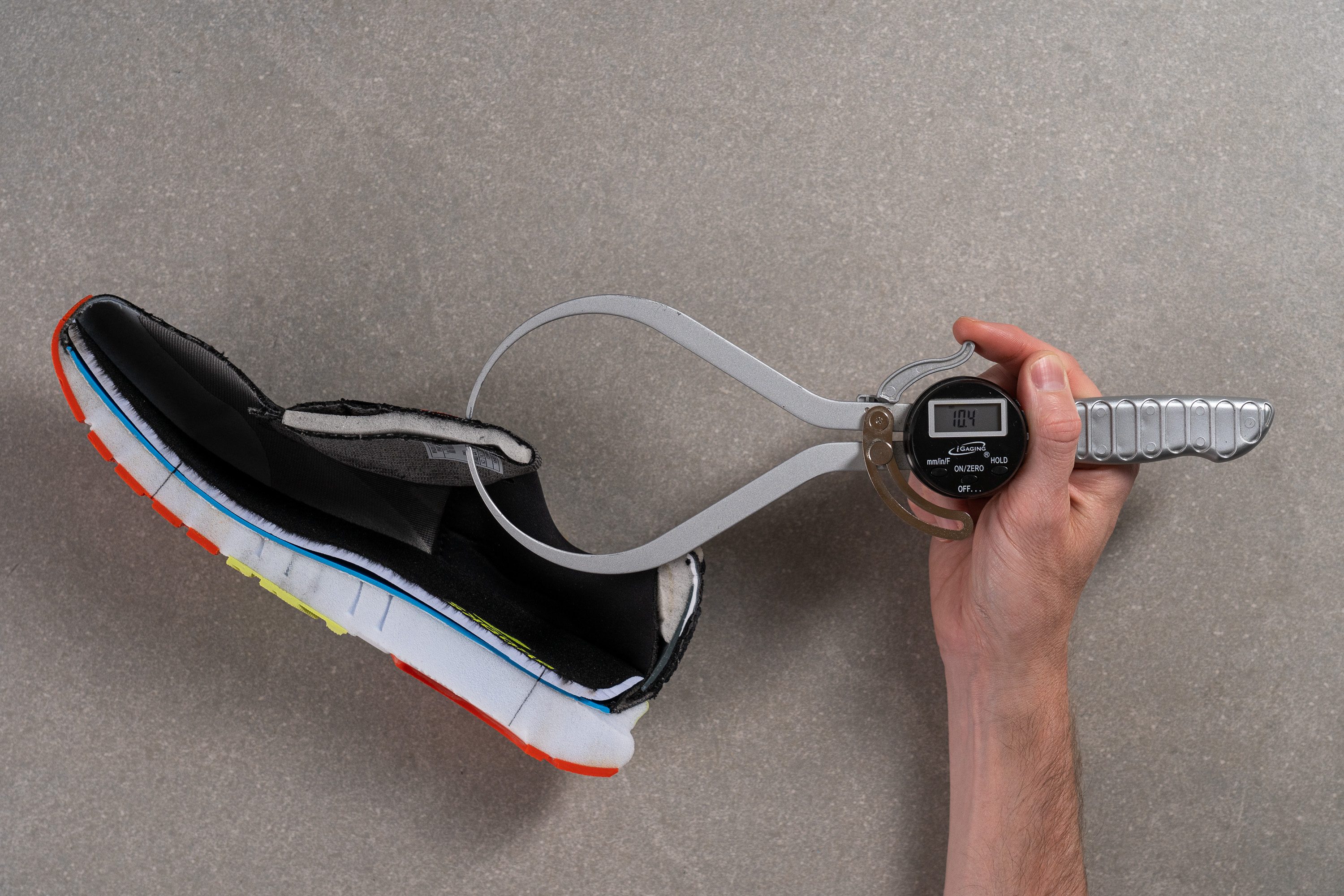
| Ghost 16 | 10.4 mm |
| Average | 5.8 mm |
Tongue: gusset type
In our Ghost 15 review, we expressed a strong desire for Brooks to integrate a gusseted tongue in the 16th edition, pinpointing it as one of the few shortcomings. Unfortunately, we will have to wait another year, as we discovered that the tongue in the Ghost 16 still moves freely.
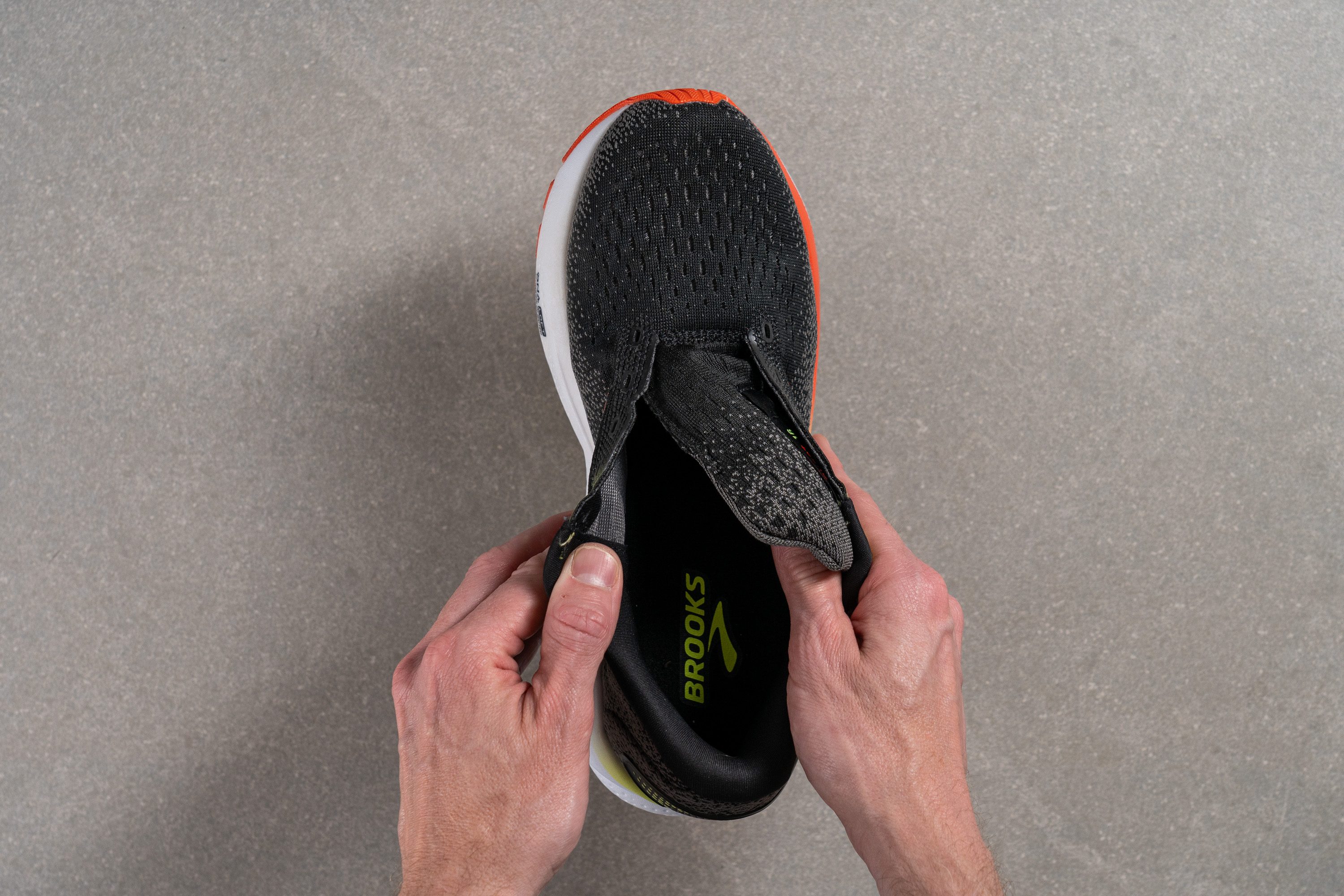
| Ghost 16 | None |
Heel tab
If there were a heel-tab-to-shoe ratio, Brooks would score super low, as heel tabs are rare in their road training shoes—though it's true that their trail models, like the Cascadia 17, often include them.
True to its design, the Ghost 16 mirrors its predecessor with a simple heel area devoid of a finger loop tab. While not a major oversight, having one would certainly make it easier to slip the shoe on.
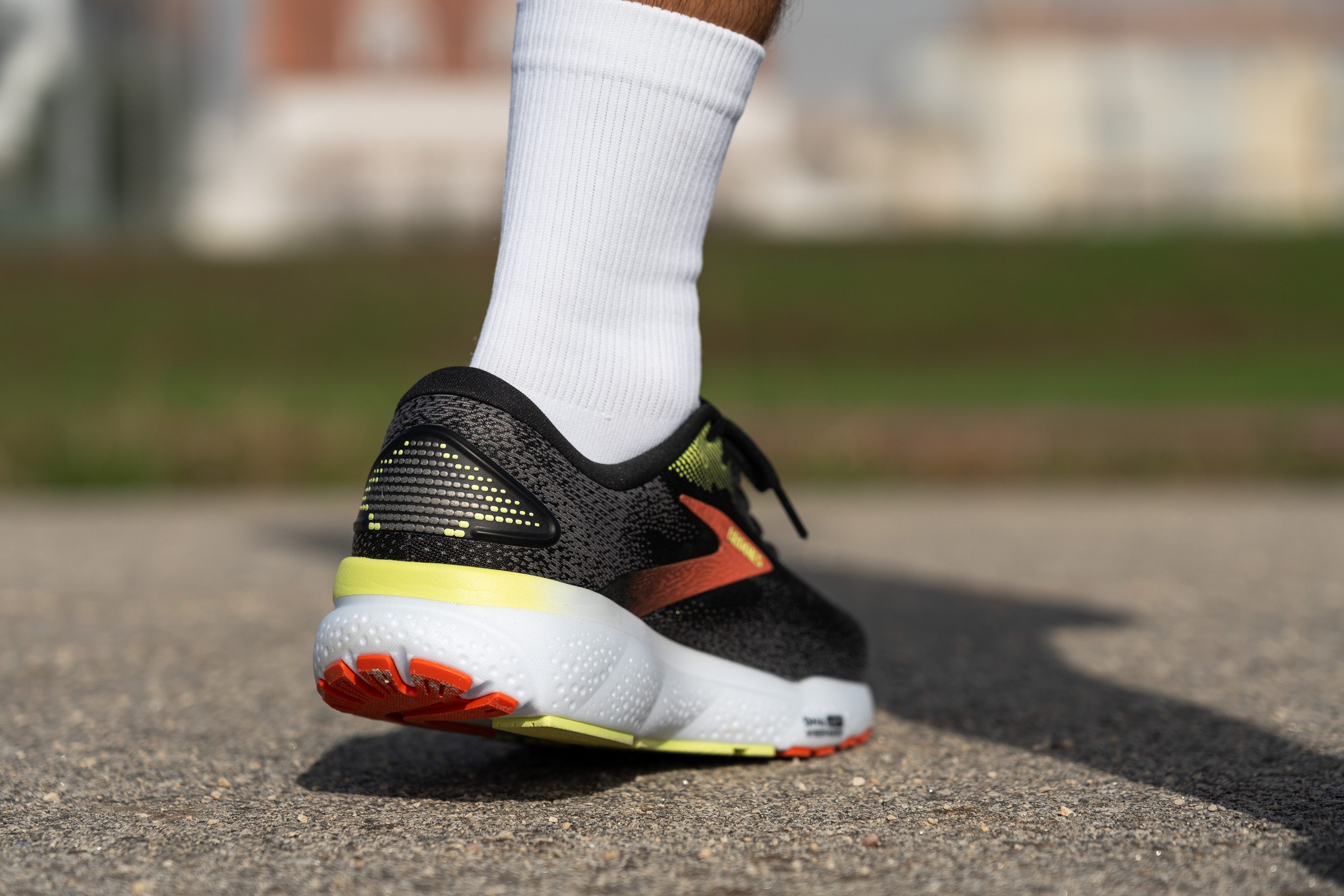
| Ghost 16 | None |

